Growing Wildlife-Based Tourism Sustainably: A New Report and Q&A
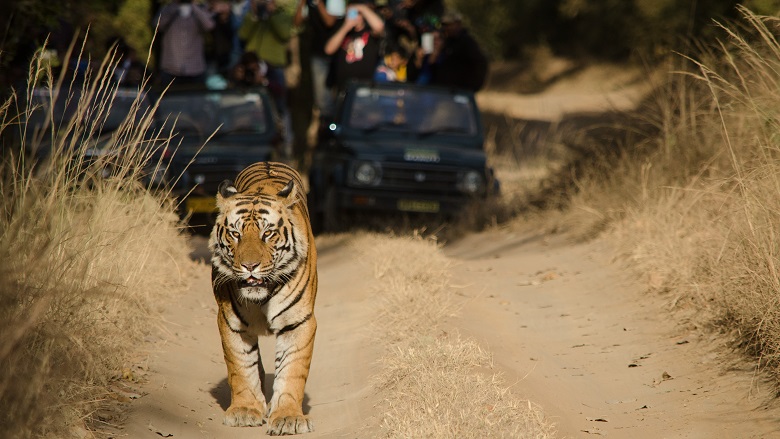
Copyright: Sanjayda, Shutterstock.com

STORY HIGHLIGHTS
- While wildlife and biodiversity are increasingly threatened by habitat loss, poaching, and a lack of funding for protection, nature-based tourism is on the rise and could help provide solutions for these issues.
- The publication Supporting Sustainable Livelihoods through Wildlife Tourism highlights successful wildlife tourism programs in seven countries in Africa and Asia that can be used as models to promote conservation and boost economies.
- World Bank lead economist Richard Damania answers questions on the drivers, innovations and challenges for wildlife tourism, and why the World Bank Group and governments should support sustainable tourism strategies.
Wildlife tourism is a powerful tool countries can leverage to grow and diversify their economies while protecting their biodiversity and meeting several Sustainable Development Goals. It is also a way to engage tourists in wildlife conservation and inject money into local communities living closest to wildlife. Success stories and lessons learned from nature-based tourism are emerging from across the globe.
“Here is a way of squaring the circle: provide jobs and save the environment,” said World Bank lead economist Richard Damania, who has extensive experience in understanding the link between tourism and the economy . In 2016, travel and tourism contributed $7.6 trillion, or 10.2%, to total GDP, and the industry provided jobs to one in 10 people, according to the World Travel & Tourism Council .
While nature-based tourism, which includes wildlife tourism, has been expanding rapidly in the last decade or so due to increased demand and opportunities, wildlife and biodiversity are increasingly threatened by habitat loss, poaching, and a lack of funding for protection.
Which is why more than ever countries need to look to concrete examples of well-planned, sustainably-run tourism operations that have led to increased investments in protected areas and reserves, a reduction in poaching, an increase in the non-consumptive value of wildlife through viewing , and opportunities for rural communities to improve their livelihoods through tourism-related jobs, revenue-sharing arrangements, and co-management of natural resources.
A recently-released publication— Supporting Sustainable Livelihoods through Wildlife Tourism —developed by the World Bank Group and the Global Wildlife Program , funded by the Global Environment Facility , showcases sustainable wildlife tourism models that can be applied to developing countries, and offers solutions and case studies to bring insight into this sector as a mechanism for inclusive poverty reduction and global conservation.
The Global Wildlife Program spoke with Damania to learn more about the growth, challenges, and innovations in wildlife-based tourism.
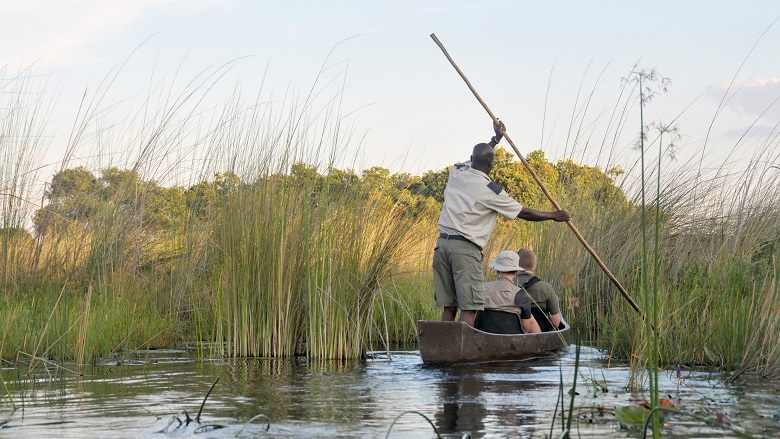
Copyright: Wandel Guides, Shutterstock.com
Why should the World Bank support conservation endeavors, and how does wildlife tourism help support our mission?
Enlightened self-interest is one obvious reason why we need to promote wildlife tourism. It provides the most obvious way to reconcile the interests of nature with the imperative for development and growth. Tourism simultaneously creates jobs while, when done well, protects natural habitats.
Prudence and precaution are another reason why investments in nature-based tourism ought to be promoted. The science of “ planetary boundaries ” warns us that many fragile natural environments and ecosystems are reaching their limits and in some cases, the hypothesized safe boundaries have been crossed. Further damage will imply that we lose important ecosystem services such as watershed and soil protection with damaging consequences for development.
But, in my mind, perhaps the most important reason is humanity’s moral and ethical imperative as stewards of global ecosystems. Simply because humanity has the ability to destroy or convert ecosystems and drive species to extinction does not make it ethically justifiable. There needs to be an ethical balance and that is where ecotourism comes in. We need jobs and economic growth, but here is a way to get jobs and growth in ways that meet our moral and ethical obligation.
What have been the drivers behind a burgeoning nature-based/wildlife-based tourism sector?
I think there are two things that drive it: as habitats diminish there is more scarcity and their value goes up. Everyone wants to see the last remaining habitats of wild gorillas for instance, or the few remaining wild tigers in India. In sum scarcity confers economic value.
Another force driving demand is the internet and rising lifestyles—you can learn about animals and habitats you might not have known existed, and more people have the ability to visit them. So, you have supply diminishing on one hand, and demand rising on the other hand which creates an opportunity for economic progress together with conservation.
What is your advice to governments and others who are developing or expanding on a nature or wildlife-based tourism strategy?
Tourism benefits need to be shared better . There is a lack of balance with too many tourists in some places, and none elsewhere. Some destinations face gross overcrowding, such as South Africa’s Krueger National Park or the Masai Mara in Kenya where you have tourists looking at other tourists, instead of at lions. We need to be able to distribute the demand for tourists more equally. The Bank has a role to play in developing the right kind of tourism infrastructure.
Those living closest to nature and wildlife must also benefit . The local inhabitants that live in the national parks or at their periphery are usually extremely poor. Having tourism operations that can benefit them is extremely important for social corporate reasons, but also for sustainability reasons. If the benefits of tourism flow to the local communities, they will value the parks much more.
We also need to be mindful of wildlife corridors . We know that dispersion and migration are fundamental biological determinants of species survival. Closed systems where animals cannot move to breed are not sustainable in the long run. As we break off the corridors because of infrastructure and increasing human populations we are putting the ecosystems on life support.
There are some who believe we can manage these closed ecosystems, but it takes an immense amount of self assurance in science to suggest this with confidence, and it is unclear that one can manage ecosystems that we do not adequately understand. A measure of caution and humility is needed when we are stretching the bounds of what is known to science.
What are some of the innovative partnerships that are helping the wildlife-based tourism businesses in developing countries?
One very successful model that has combined wildlife conservation and management and community benefits and welfare is the Ruaha Carnivore Project in Tanzania, part of Oxford University’s Wildlife Conservation Research Unite ( WildCRU ). They use a payment for ecosystem services (PES) scheme and do all the right things.
Another example are the community conservancies in Namibia. The community manages the land for wildlife and there are a variety of profit sharing commercial tourism arrangements—although not everything always works fairly or perfectly. Incentives matter deeply and communities need to be guided and need technical assistance in setting up commercial arrangements.
The Bank needs to understand these better and find ways of scaling those up. The IFC has a very good role to play here as well.
To learn more and to explore numerous examples of community involvement in wildlife tourism from Botswana, India, Kenya, Malawi, Namibia, South Africa and Uganda, read the report Supporting Sustainable Livelihoods through Wildlife Tourism or find a one-page fact sheet here .
The Global Wildlife Program (GWP) is led by the World Bank and funded by a $131 million grant from the Global Environment Facility (GEF). The program is working with 19 countries across Africa and Asia to promote wildlife conservation and sustainable development by combatting illicit trafficking in wildlife, and investing in wildlife-based tourism.
- Full Report: Supporting Sustainable Livelihoods through Wildlife Tourism
- Fact Sheet on Key Messages
- Report: Twenty Reasons Sustainable Tourism Counts for Development
- Report: Women and Tourism: Designing for Inclusion
- Blog: Africa can Benefit from Nature-based Tourism in a Sustainable Manner
- Feature: Ramping up Nature-Based Tourism to Protect Biodiversity and Boost Livelihoods
- Website: Global Wildlife Program
- Website: Environment
- Website: Competitiveness
- Global Environment Facility

17 BEST PLACES TO SEE WILDLIFE IN ASIA AND AUSTRALIA
Updated January 2022
The best places to see wildlife is in the wild. If that’s not possible, wildlife reserves are an alternative. If you’re an animal lover or interested in animal conservation, then planning a trip to see wildlife should be on your travel bucket list. We asked some fellow travel bloggers for the best places to see wildlife in Asia and Australia, particularly Australia’s wildlife sanctuaries , and they did not disappoint.
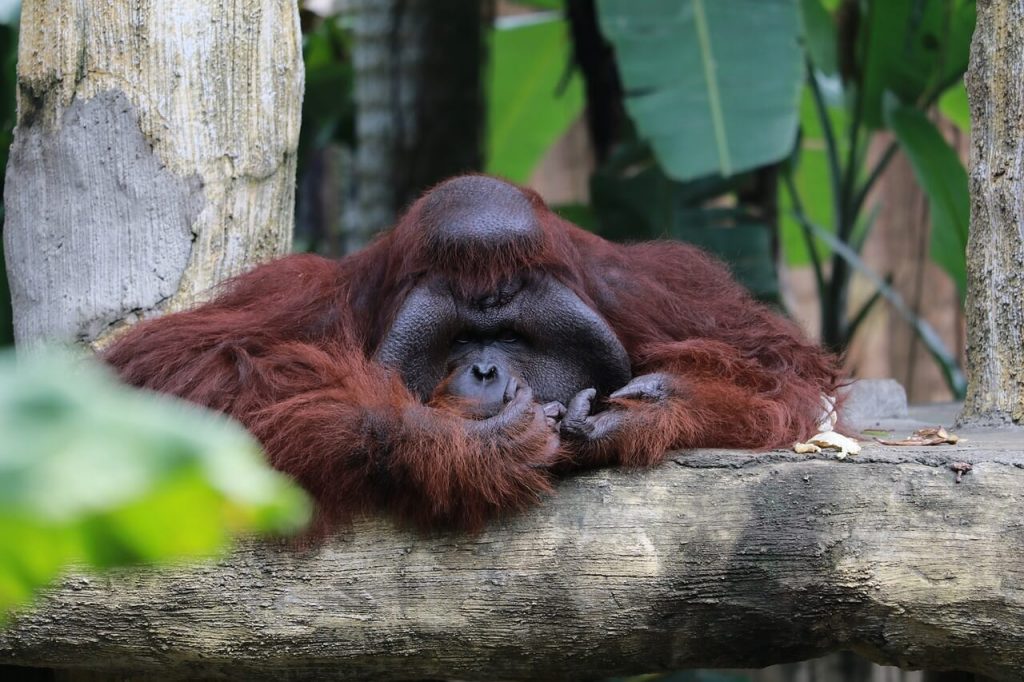
Table of Contents
Best Places to See Wildlife in Asia
Blue whale watching in mirissa, sri lanka.
Mirissa, a small town in the south of Sri Lanka, is an essential stop for wildlife lovers and one of the best places to see wildlife in Asia. While the country’s national parks offer the chance to see some incredible animals, from leopards to elephants, Mirissa offers something different. This small town is one of the best places in the world to see blue whales! Mirissa’s main whale watching season runs from November to April. Trips during this time have around a 95% chance of seeing whales. Although tours do still run between May and October, whales are seen less frequently due to rougher seas. It’s also more likely that tours are cancelled due to the weather during these months. We visited Mirissa in December 2017 and decided to take a whale watching tour on Christmas day. A tuk tuk was sent to pick us up at 5:45 am to take us to the port. As we set off we were treated to a lovely sunrise, hoping we’d be lucky enough to see some whales and make it a Christmas to remember!
Just a few hours later we were in awe as we caught our first glimpse of a blue whale, but it didn’t stop there. Over the course of the next few hours, our crew pointed out well over 10 blue whales. We had some incredible views as the whales surfaced to breathe before diving back down into the depths of the ocean. On the boat ride back to the town we also saw a couple of turtles. Although we only saw blue whales and turtles, the tours do often encounter plenty of other species – from orcas to dolphins to whale sharks. Some whale watching tours in Mirissa don’t seem to care about the wellbeing of the whales, so make sure to check reviews before booking with an operator!
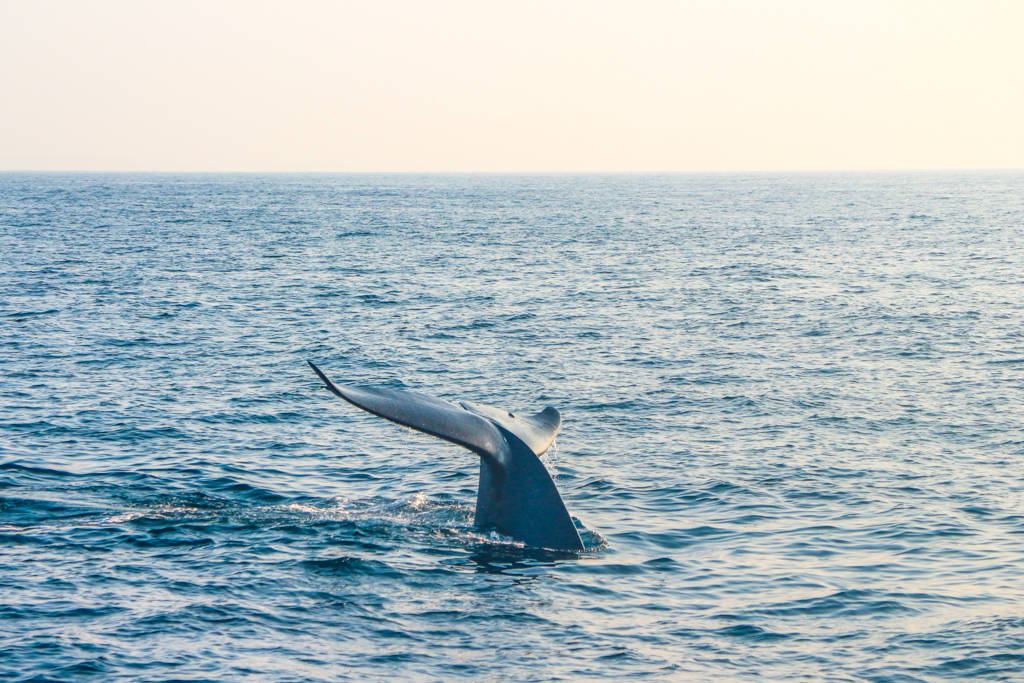
Sam Ward blogs at Something of Freedom .
A Jungle Safari in Karnataka, India
We booked our first real expedition into the wilderness on a sweltering summer day, at Bandipur National Park with the Jungle Lodges, the first eco-tourism venture in India. Bandipur is a beautiful, unapologetically wild terrain nestled in the lush green Western Ghats of India, which is blessed with a great diversity of flora and fauna, ideal for Asia wildlife viewing. It is one of the four borderless national parks spread across three states of India and is home to the largest population of tigers in India. This makes India one of the best places to see wildlife in Asia.
Once the favorite hunting ground of the Royals of Mysore, Bandipur was turned into a protected area, a safe haven for the wild including leopards, bears, Indian Sambar, spotted deer, elephants, peafowls, and many other exotic species including the tigers. Our 6-hour jungle safari was split into two sessions of 3-hours each, one in the afternoon and one in the early morning. We went in an open jeep to discover the beauty of wildlife in their natural habitat. We got to see several animals, the beautiful sunset and the sunrise the following day, but the tiger remained elusive, until the last moment when we were about to leave the jungle with a heavy heart. So yes, our tryst with the tiger did happen after all, and it will be one of the memories to cherish forever. What I like the most about Bandipur is the ethical tourism practices. Even today no vehicle can cross the forest between 9pm to 6am, a law that has been contested by many political forces but still stands to protect wildlife.
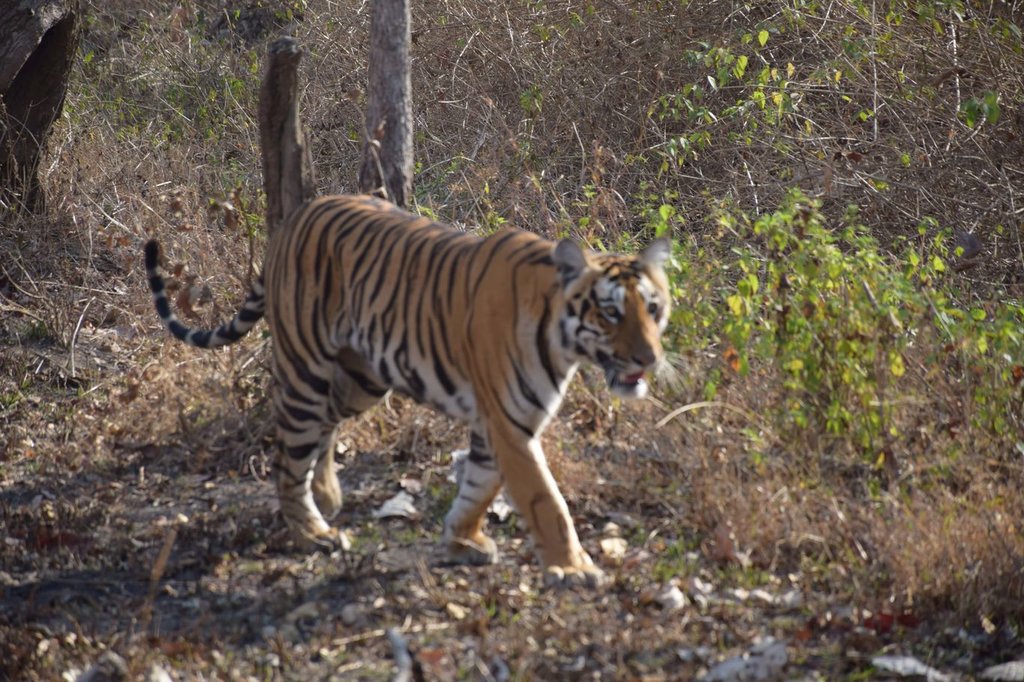
Sinjana blogs at Backpack & Explore .
The Great Monkey Attack of Angkor Wat, Cambodia
The best places to see wildlife may be where you least expect it. Wildlife in southeast Asia can be especially unpredictable. You don’t need to take a wildlife tour of southeast Asia to find yourself in the middle of a wildlife, shall we say, “situation” especially as it relates to monkeys.
During our trip to Angkor Wat in Cambodia, we arrived at our guest house late at night. Next morning, we left to see the temples but saw two huge monkeys blocking our entrance to the road. We walked towards them making noise and waving our arms expecting them to scatter but instead, they approached us. As we considered what to do, a monkey came from behind, jumped on my back and tore at my backpack that had a couple of packets of dried fruit. I was shocked and began screaming “get it off!…get it off!” We ran to the road while a couple of monkeys chased us. Once out of monkey-range, we looked back and saw them staring at us. I could swear they were laughing. I couldn’t believe what had just happened. We had actually endured a strategically executed attack by a troop of monkeys!
The monkey attack was all we talked about that day. When we returned to our guest house that evening, there were no monkeys in sight. Next morning, we were getting ready to leave when we heard a screeching animal sound. We looked out our window and saw monkeys gathering in front of our guest house. They were looking straight at our room! There were 12 to 16 large monkeys right outside our door. And those were just the ones that we could see! There was no way we were getting out of there and onto the road with our stuff. Suddenly I saw the woman that checked us in the first day. She walked towards out room with a large dog. The monkeys scattered which gave us enough time to get to the main road with our bags. As we left, the woman smiled apologetically and told us the monkeys could sometimes get “frisky.” We were happy we survived the great monkey attack of Angkor Wat.
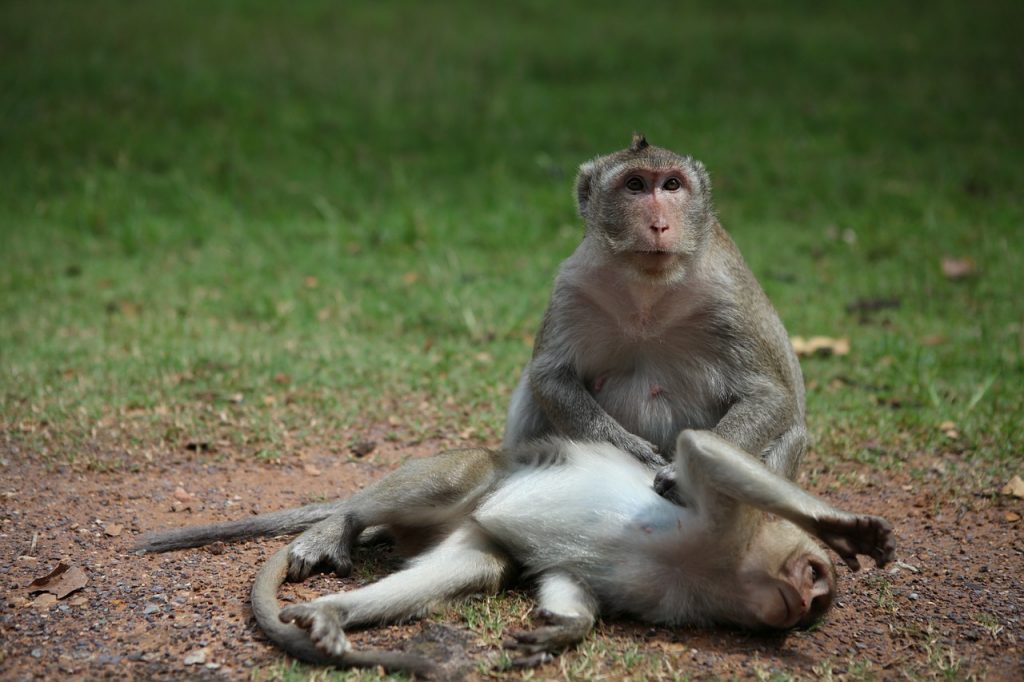
Talek blogs at Travels with Talek .
Pygmy Elephants in Borneo
Seeing pygmy elephants in Borneo takes time and effort. In Sabah in the north of Borneo, you can take a 4-hour speed boat from Sandakan up the slow-moving brown Kinabatangan River, which is laden with silt and surrounded by palm trees at first and then thick jungle, to a rain forest lodge. From there, you can take another boat a couple of more hours upriver, past proboscis monkeys and macaques jumping around in trees, golden crocodiles lazing on muddy banks, and black and white hornbills flying overhead to get to where pygmy elephants are on their migratory march across part of the island. Pygmy elephants are the smallest elephants on the planet, with large ears and long tails, and are endemic to Borneo and nearby islands.
After more than an hour of peering intently into the jungle but seeing nothing but trees, we saw a small boat pulled alongside, half hidden under overhanging vines. Inside were two fellow guests from our lodge, who had been temporarily abandoned by their guide, as he headed into the jungle to look for tracks. They were pulled alongside a tiny inlet completely hidden from the river. A grey elephant slowly emerged from the trees and made its ways slowly down the sloping banks and into the shallow inlet. Another elephant joined it, as they crossed the inlet, then walked slowly up the other side and lumbered back into the jungle. It was a completely magical moment. What a wonderful opportunity to see wildlife in Asia!
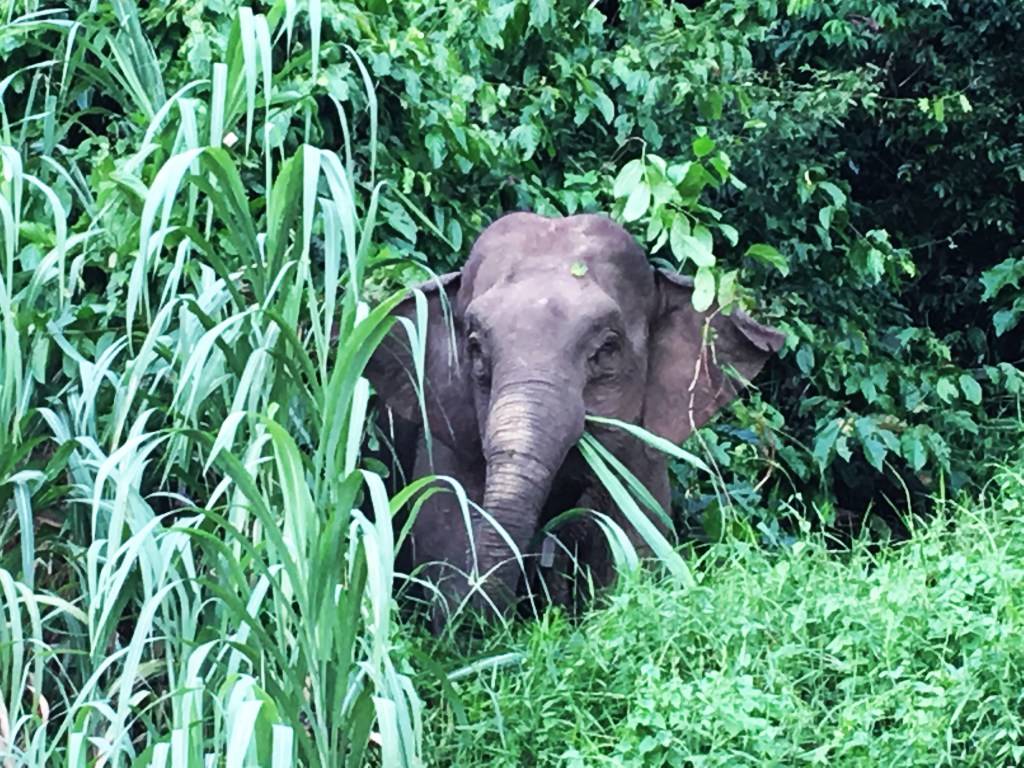
James Ian blogs at Travel Collecting .
Tarsiers and Black Macaques in Sulawesi, Indonesia
When we were in Sulawesi, Indonesia, we had an opportunity to visit Tangkoko Nature Reserve. A few years ago, this reserve caught the media’s attention when a black crested macaque became the centre of a “monkey selfie” lawsuit brought by PETA.
We visited Tangkoko to view the Tarsiers, the smallest primates in the world which has eyes as big as saucers. They do not fare well in sanctuaries as they are sensitive to daylight, noise and physical contact, so the most ethical way of seeing this yoda-like creature is in its natural habitat.
Walking through the Reserve to see Tarsiers we passed a family of black macaques. Observing protocol of keeping our distance, we stopped and watched them running and tumbling as monkeys do. A few were being groomed, and as my husband crouched down to take a photo of the chief, a monkey groomer jumped onto his shoulders. He began rubbing Sy’s shaved head and feeling his stubbly chin, so Sy gently lifted up his mobile phone and snapped a photo of them both. Thankfully the monkey jumped down not long after, leaving Sy with a great photo and a smelly t-shirt!
We continued towards the Tarsiers; it was a bit of an anti-climax after the macaques but nevertheless, a wonderful encounter all the same. Tarsiers only come out at dusk, so we waited until there was movement in a large tree. As they started to wake up, they began hunting and jumped huge distances from tree to tree. These tiny little primates looked adorably cute with their soft fur and freakishly long fingers. We will always remember our unusual and interesting wildlife encounter at Tangkoko Nature Reserve, one of the best places to see wildlife in Asia.
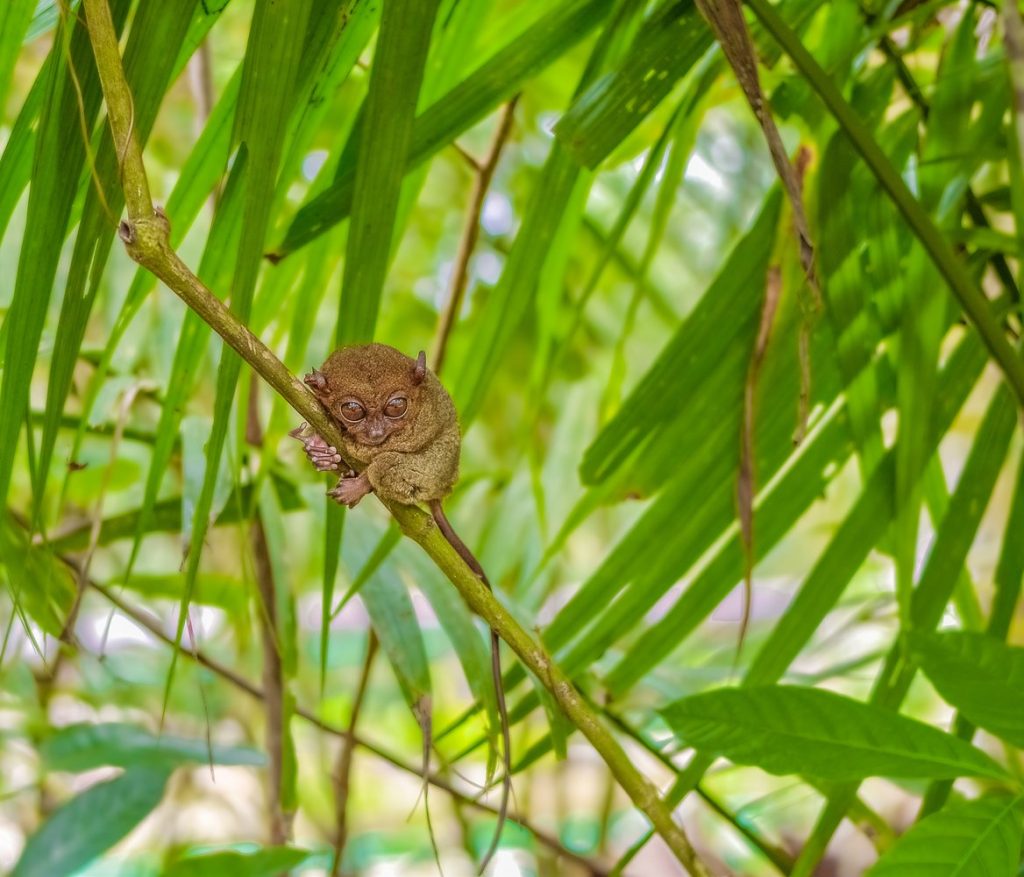
Angie blogs at Feet Do Travel .
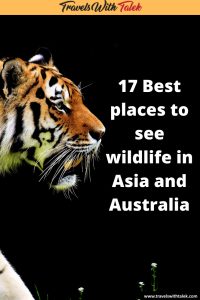
Swimming with Turtles in Apo Island, Philippines
One of my best wildlife adventures was seeing and swimming with sea turtles in Apo Island, Philippines.
Apo Island is actually a declared marine preserve, and it’s located in the Coral Triangle – a huge area spanning different countries known for its high marine diversity. To get here, I took a flight to Dumaguete and then signed up for a day tour in Apo Island. The first activity in the tour is to see sea turtles in the wild.
A tour guide led the group in the water, and we swam for several minutes before spotting a sea turtle. We then circled the perimeters of the island and saw a few others. What’s remarkable to me here is that the sea turtles didn’t mind the presence of people (unlike in other places where they try to get away when you approach them), although of course we kept our distance. Our tour guide explained that the turtles are used to humans and know that the latter do not harm or disturb them, which is great. Some of the sea turtles were really big and a few decades old. Keeping at least a meter or so away from the turtles, we took great underwater shots with them at the backdrop. Swimming with the turtles in Apo Island is certainly a wildlife experience I’d never forget, and Apo Island is one of the best places to see wildlife in Asia.
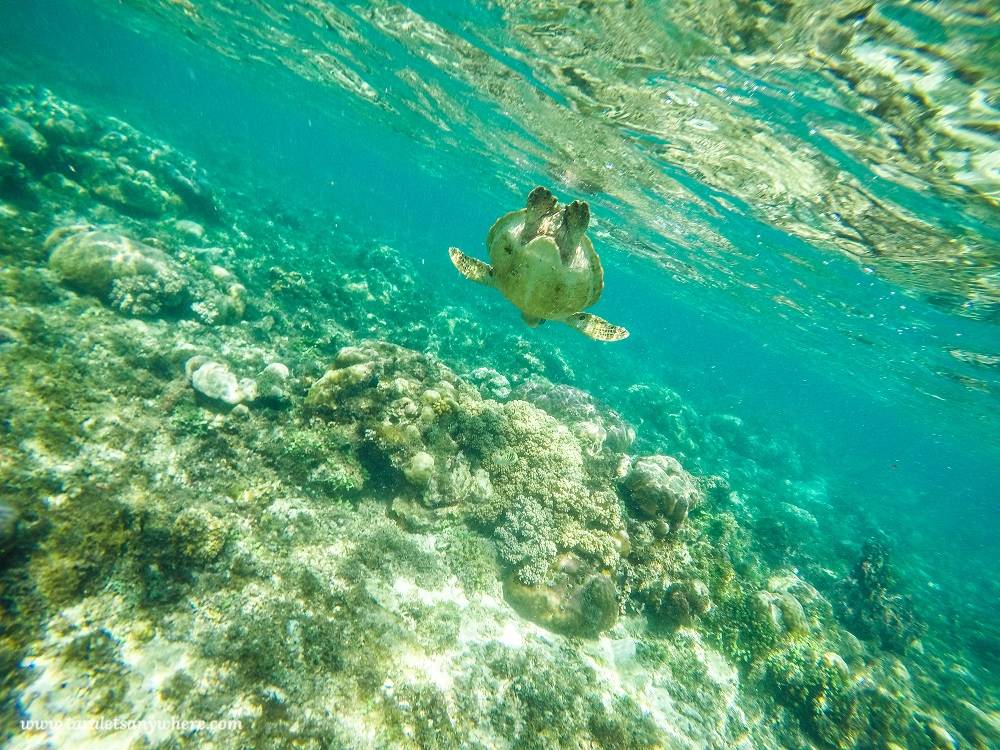
Katharine blogs at Tara Let’s Anywhere .
Kaudulla National Park, Sri Lanka
Asian elephants are an endangered species, so any opportunity to see them in the wild is special. The population has declined by 50% in the last three generations and there are only 40,000 left across the whole of Asia (6,000 of them being in Sri Lanka). This is why a visit in July or August to Kaudulla or Minneriya in Sri Lanka is truly special. At this time of year, it won’t be whether you see an elephant it will be how many! They are often seen around the dwindling waterholes in herds of up to 200.
We were lucky enough to see 110 on our visit (yes, we counted!). Many elephants came right up to the jeep, and it was incredible to see so many in one spot, including loads of gorgeous calves. It’s quite hard to describe in words how magical it is to get up close to these beautiful animals, it would make a trip to Sri Lanka worth it for this experience alone. The best way to see the elephant gathering is by hiring a jeep from the nearby town of Sigiriya. They are pretty flexible with the times you go, though they recommend going in the afternoon, and you can book a private jeep that will take you to the park for 4 hours for 4,500 rupees ($28 USD). The jeeps have an open-air top, so you can stand up and watch the elephants from high up, giving great views across the plains.
Whilst Minneriya is closer to Sigiriya, you will be there with a lot more people, so we chose to visit Kaudulla. It’s best to check with the locals in town as to where the elephants currently are – although they are usually be seen in both. The access roads are pretty rough, but once you get to where the elephants are you won’t move too much. You’ll simply drive up, stop and start counting how many you can see.
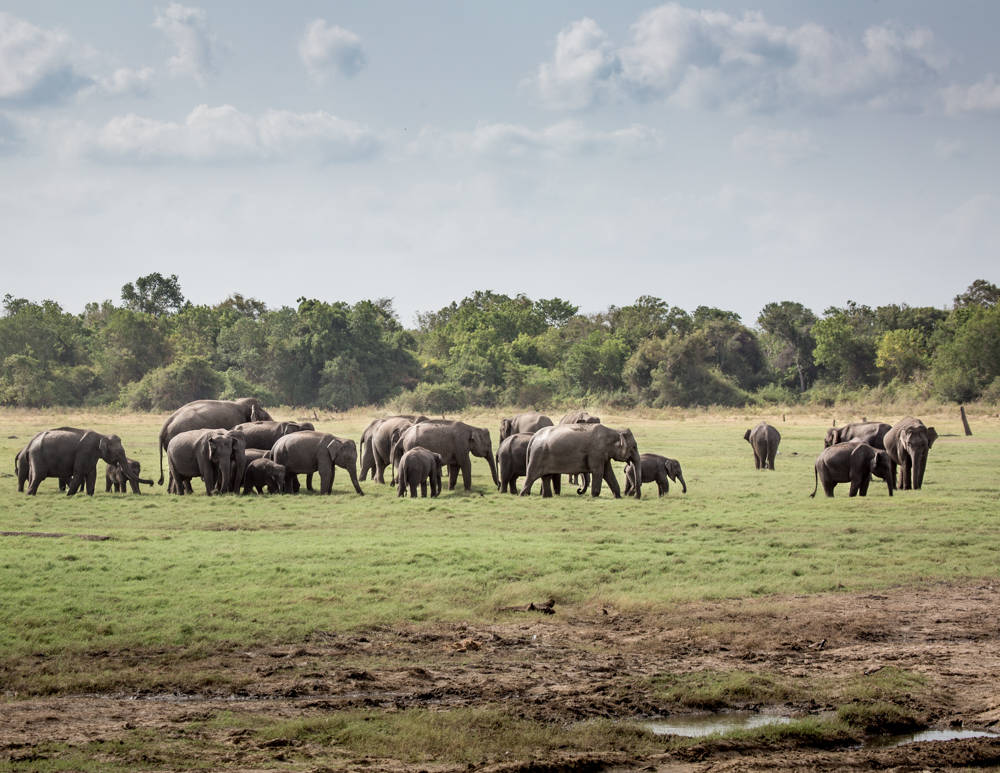
Cat Smith blogs at Walk My World .
Seeing Monkeys in Lopburi, Thailand
Earlier this summer I was travelling through some parts of Southeast Asia, and after hearing many stories about Lopburi in Thailand I knew I had to visit it. I live in Europe; I’m not really used to seeing monkeys. And Lopburi is often described as a city where monkeys have taken over. I knew I had to visit!
From Bangkok, it is an easy 2-hour train ride to Lopburi. Once I arrived it was obvious that I was in the right city, as right in front of me after getting off the train was a huge 2-meter tall, brightly coloured statue of a big monkey. They are proud of their monkeys in Lopburi!
The monkeys tend to mostly congregate in the area of the old temple ruins called Phra Prang Sam Yot. As you approach the area, the more monkeys you see hanging out on the roads and walls. But once you actually enter the Phra Prang Sam Yot area you are surrounded by at least a couple hundred macaque monkeys. They seem to either chill out in the hot sun with the other monkeys (sometimes picking at each other’s fur) or are on the lookout for food to snatch from the tourists who visit the area.
There are a few workers who will sell snacks that you can feed the monkeys for 50 baht. We bought some corn, which the monkeys quickly noticed and circled us. Feeding the monkeys out of our hands was definitely the most enjoyable part, however even just watching this huge number of monkeys relaxing with each other was fascinating as well. The monkeys seem quite harmless, but they did jump on us a few times. There is a hosepipe near the entrance where you can wash your hands, arms, back, hair and wherever else the monkeys climbed on you! If you are in Bangkok and love monkeys, then I really recommend that make the train trip to Lopburi.
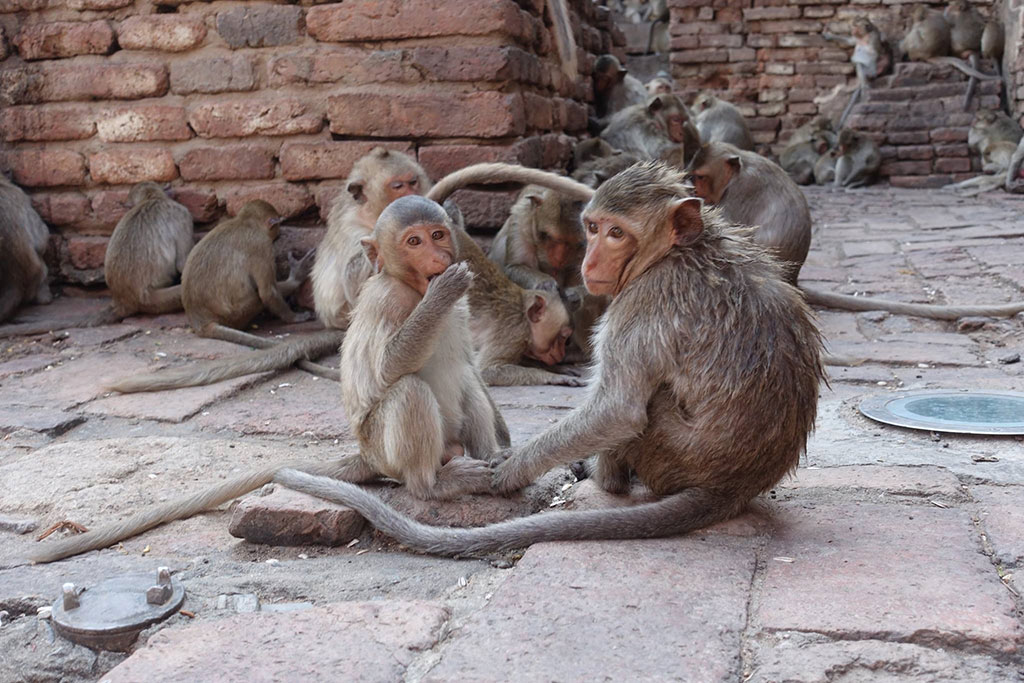
Patrick blogs at Complete City Guides .
Sea Turtles in Tioman Island, Malaysia
My family and I wanted to have an ethical experience with sea turtles in Southeast Asia in 2017. We volunteered for a week with the excellent Juara Turtle Project on Tioman Island, as they accept families and need unskilled volunteers to help with many of their tasks. It was a busy and fun week in which we patrolled the beach looking for evidence of nesting mothers, participated in trash clean-ups and daily chores, and spoke to visitors to the centre about the Project’s work.
We didn’t see a mother turtle in that week, but we did see hatchlings! The night we arrived a few latecomers emerged from a nest and we were woken to see them scurry to the water. A few days later the team and volunteers excavated that nest, as they count how many eggs didn’t hatch and record the reasons they didn’t. In the excavation a couple of turtles were found alive! They were too weak to get out by themselves, so they didn’t have much chance of making it, but they were still released into the ocean with all of our hopes behind them. And to complete the circle, some eggs were discovered on the boat patrol that day and brought to the hatchery, so we got to help transfer them into their new nest too. It was fascinating and amazing work.
We monitored the hatchery daily and could see that another nest was going to hatch soon, because the sand on top of it was moving and shifting all the time. But when our week finished the baby turtles still hadn’t emerged, much to our disappointment. Luckily, we were only staying nearby, because our friends at the project called the night, we left to tell us the nest had hatched! We finally got to see a full nest of over 100 hatchlings be released, and the spectacular sight was worth the wait.
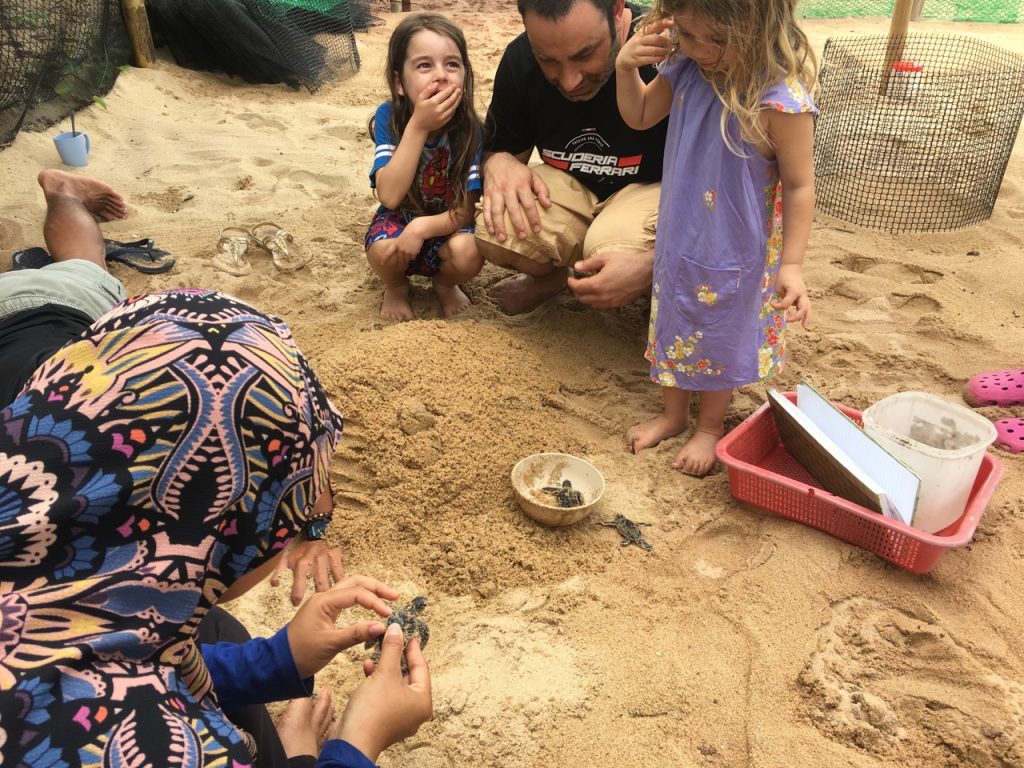
Read the complete adventure at Small Footprints, Big Adventures .
Bardia National Park – Nepal
Each time I thought about getting to Nepal, I thought about trekking and enjoying the Himalayas. Not once did I think that I would actually end up going to Nepal on an animal adventure. My husband really wanted to see tigers in their natural habitat, so this is how we ended up in Bardia National Park.
Bardia is, in my opinion, Nepal’s hidden gem. It’s a great natural park filled with wild animals and with a friendly community surrounding it. Unfortunately, it is not easy to reach it, either via a flight from Kathmandu to Nepalgunj and from there getting a jeep or riding a bus or via a 17 to 19-hour bus ride from Kathmandu. We spent two days roaming around the park together with a ranger and his aid. It was amazing as there were no other tourists. I kept on thinking about the photos from Chitwan where you see tons of people, and there are even traffic jams with the safari jeeps taking tourists to observe the animals. So, definitely, Bardia is a much better option.
The experience itself was excellent as it is not easy to spot a tiger and a lot of times people spend days and return unsuccessful. After quite a while, we got to see the tiger passing a small pond in front of our eyes. We were fortunate to see other animals as well; rhinos, a herd of elephants playing in the water, tons of deer and monkeys, a snake, a jackal, a peacock, and of course, the majestic tiger. If you want to experience nature as it is, then Bardia is the place to go. And you might be lucky and see the tiger as well.
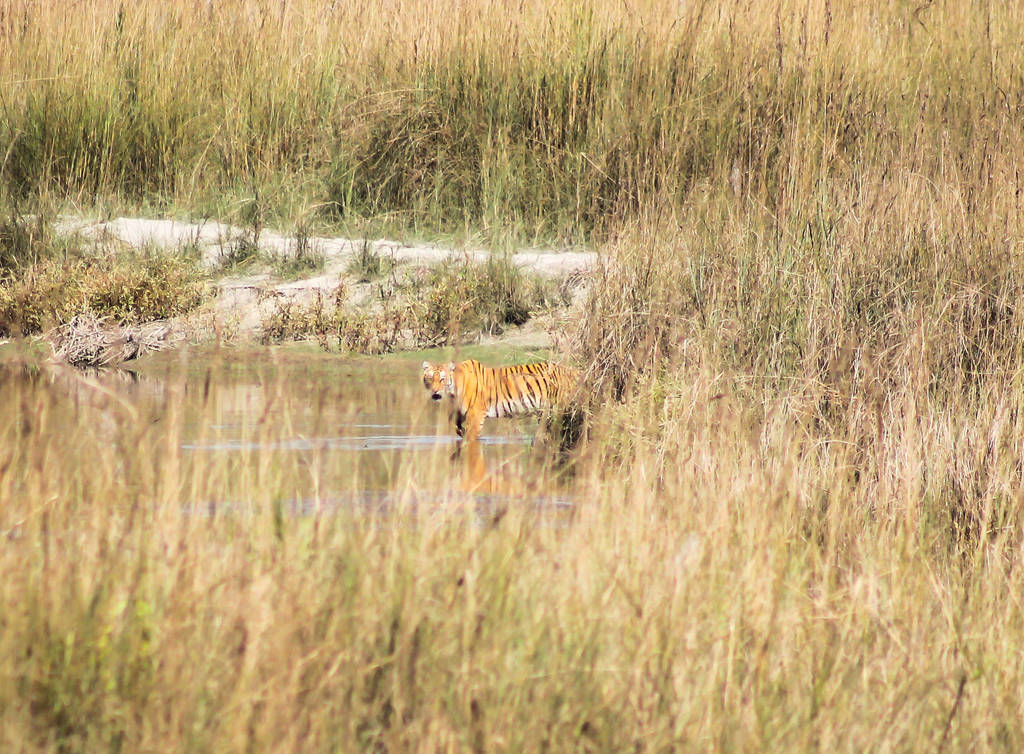
Andra blogs at Our World to Wander .
Diving with Giant Mantas in Komodo National Park – Indonesia
Komodo Island in Indonesia is very well known because of the dragons of Komodo that can only be found here. But what most people don’t know is that the underwater region near this island is also spectacular.
We have gone diving in more than 100 spots on 20 different countries, but Komodo is on top of all our lists as the best one we have ever been to. Here you can find a great variety of underwater life with many fish of all kinds and corals of vibrant and beautiful colors. The most interesting diving point here is the giant mantas. At first sight you will only see an undersea desert with almost no life. But suddenly, a giant and wonderful manta will appear in front of your eyes. These animals can only be seen in their natural environment in few places around the world. Even though you only get to spot one in the far distance, you still feel rewarded.
For us it was an awesome experience. We got to see two or three from far and one very close that just flew in front of us. Because of the depth and sometimes strong current, you need to be an advanced diver. But the good part is that you can take the diving course at the island and the locals will not have any problem taking you here for your first diving experience.
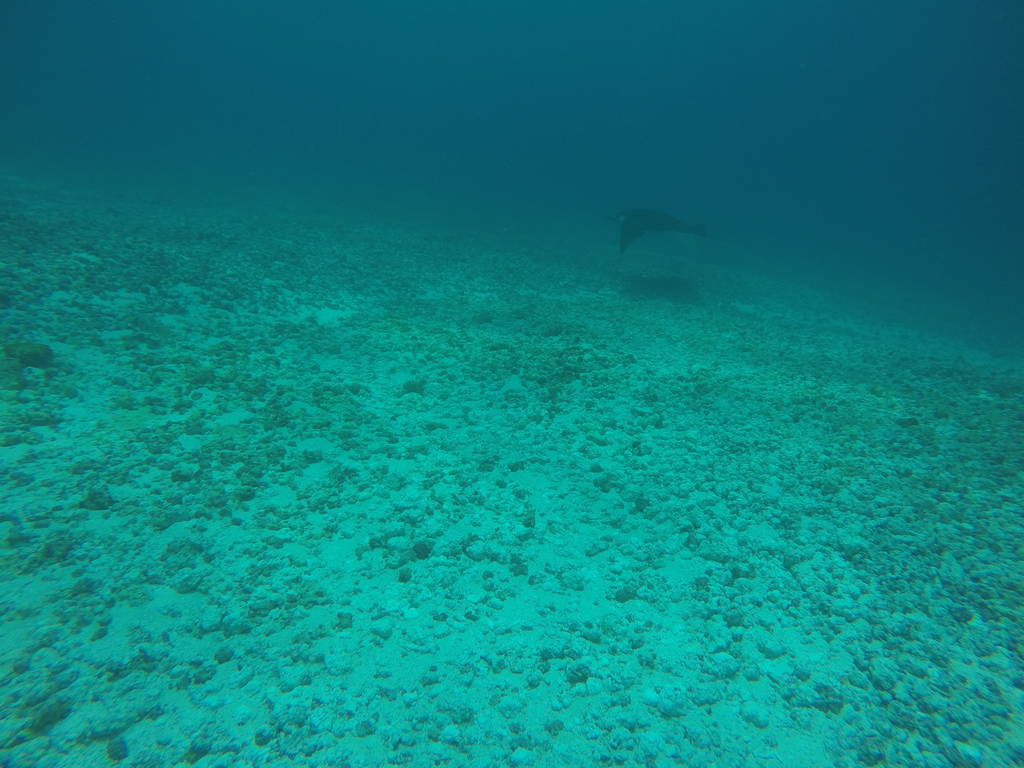
Walking with Lions in Mauritius
Mauritius, a island where you can explore the exquisiteness of nature, also encompasses a “fear factor,” called Walk with Lions at Casella Nature Park. It wasn’t an easy decision to take part in this, but we decided to do it as a memory to last a lifetime. Shivers ran down our spines when we had to fill out a disclaimer form taking responsibility for any untoward episodes. We also learned we had to defend ourselves with lean sticks as the only weapons for 45 minutes in the deep jungle!
With numerous directives from our guides, we heard the the huge lions known as Ginger and Mauli approach us from their protected area. Their gracious presence terrified us. But slowly they became a part of our troop, walking, rushing into the fields, and climbing the rocks. I was given the memory of a lifetime by being allowed to touch their manes and feed them. Ginger turned his head and eyes towards me, and with fear I closed mine. But in the next moment, he was nibbling the feed, and I was still safe. Soon we ended our walk and pledged to save these gracious cats. They are truly a wonder of the world, and it is an adventure you shouldn’t miss!
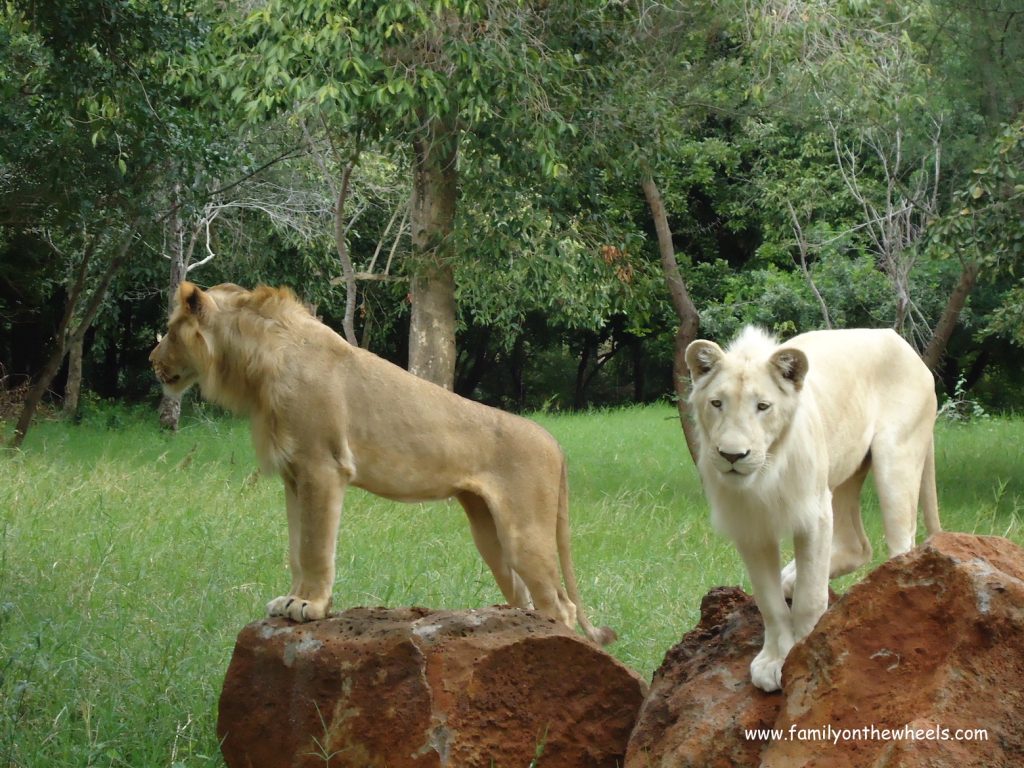
Chandresh Jain blogs at Family on the Wheels .
Swimming with Turtles in the Maldives
Maldives is famed for its crystal blue water and snorkeling, so it shouldn’t be surprising that it’s almost a guarantee to spot turtles in the ocean.
I was staying on the local island of Gaafaru 3 hours boat ride from the capital, where they offer a sea turtle snorkeling excursion. The locals know exactly where the beautiful creatures like to hang out. So it was as easy as hopping on a speedboat for thirty minutes to the area where they are commonly spotted.
The locals are no strangers to sea turtles, and the sea turtles didn’t seem to mind humans, either. We saw no less than five turtles during our snorkel, swimming alongside them as they come up for air. One even started to eat the food fed by the staff who accompanied us!
The turtles we saw were Hawksbill and Green turtle, though there are three more species of turtles out of the seven in Maldives. Generally, Green Turtles are larger and the patterns on the body are less prominent. While it’s exciting to spot the turtles, there are also plenty of fishes and other marine life in the area. We even saw an octopus hiding in the corals!
Nam blogs at Laugh, Travel, Eat .
The Elephant Jungle Sanctuary in Chiang Mai, Thailand
The Elephant Jungle Sanctuary is a sustainable eco-tourism project located in Chiang Mai, Thailand. It is a joint mission between people of the Karen-hill tribes and Chiang Mai Locals.
There are many places to see elephants around Thailand, but what appealed most to me about this one was their dedication to make a positive change in the way people see elephants. To reach a future where elephants are not poached, being rode on, used for entertainment or manual labor, and are instead treated with love.When you arrive at the sanctuary you are given a brief lesson about how Asian elephants are endangered and mistreated. What’s cool is that you get to wear traditional Karen-hill tribe clothing. When I asked the people from the tribe why they had similar shirts, they answered that the designs and colors make the elephants feel comfortable around anyone wearing it.
After the elephants come out. You’ll be amazed at how enormous they are if this is your first time seeing one up close. You begin by feeding them bananas and sugar cane. Afterwards you get into a mud bath with the elephants and massage their bodies. From there you lead them into a freshwater river where you clean off the mud from their massive bodies.
The reason all of this is done is because if elephants are left in the wild, it becomes almost impossible to interact with them. The bathing and mud spa show the elephants that we really care for them. A sign of trust and affection that the elephants can no doubt feel from us.
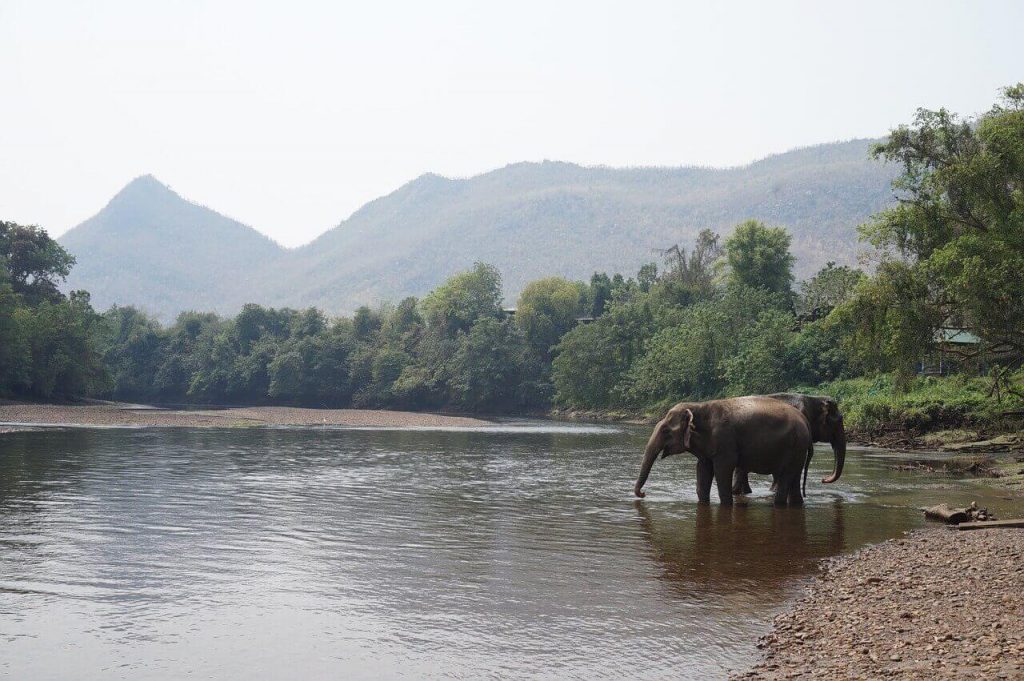
Best Places to See Wildlife in Australia
Spotting kangaroos and wallabies in cape hillsborough – queensland australia.
Have you seen those wonderful images of kangaroos and wallabies on a beach at sunrise that often appear in brochures for Australia, one of the best places to see wildlife? Invariably those images are taken on one beach in Queensland at Cape Hillsborough National Park. The park is located a short 30-minute drive north of Mackay in Northern Queensland.
The kangaroos and wallabies come down to the beach at dawn to feed on seed pods that are washed up onto the shore. To be sure to see the kangaroos you need to be on the beach before the sun rises. If you are able to do this in summer whilst it will be warmer you will need to be up a lot earlier. In winter it is cold, but you can have a slightly later start.
The kangaroos and wallabies spend about an hour on the beach feasting on the seed pods before returning to the shelter of the trees. Although they are used to people it is important to remember that they are wild animals – do not try to touch or feed them.
I have been to see the kangaroos on three different occasions – once in winter and twice in summer. Driving to the beach and parking up is so exciting as you don’t know how many kangaroos you will see. We have seen lots of joeys and kangaroos bounding down the beach.
Taking beautiful images of the kangaroos and wallabies at dawn remains a wonderful memory of those early mornings. And just appreciating the privilege of being so close to some of Australia’s most iconic animals is a dream come true.

Tracy blogs at Tracy’s Travels in Time .
Crocodiles in Kakadu, Northern Territory, Australia
Apparently, there are over 100,000 wild crocodiles in Australia’s Northern Territory and around 10,000 of them live in Kakadu National Park.
One of the best places to see crocodiles is from the 2-hour Yellow Water River cruise along the Yellow Water Billabong.
During our cruise we saw 17 crocodiles! From 1 metre female crocodiles to giant monsters at over 5 metres. During the cruise the experienced guides educated the passengers about crocodile safety in Kakadu as well as told us stories of crocodile behaviour. The most impressive crocodile we saw was well over 5 metres and was slowing zig zagging up the billabong alongside the boat. In his mouth he had something large, submersed under the water which appeared to be a log. Our guide was quite intrigued as he said crocodiles don’t usually carry logs. Weren’t we all completely shocked when the crocodile brought his prized possession slightly above the water’s surface to reveal he was carrying a feral pig in his mouth! During our cruise we also saw wild brumbies, ducks, various bird species and snakes. The Yellow Water River Cruise was one of the highlights of our entire trip in the Northern Territory.
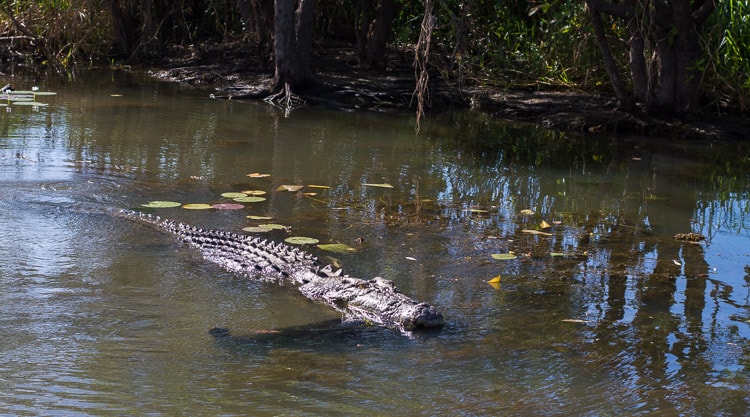
Melissa blogs at Thrifty Family Travels .
Koalas in Victoria, Australia
One of the best wildlife adventures in Australia has to be the marvelous koalas of Raymond Island, Victoria, Australia. This is certainly one of the best places to see wildlife in Australia.
Located on the eastern coast of Victoria in the Gippsland Lakes, and close to the popular town of Lakes Entrance, Raymond Island is easy for visitors to access. Passengers on foot can catch the regular car ferry from Paynesville across the waterway for free. Upon arriving, visitors quickly find themselves face-to-face with koalas mere metres away from the ferry landing point.
Follow the signs, located near resident homes in suburban streets, for a beautiful walk through a parkland of highly populated gumtrees. Here you can view hundreds of gorgeous koala bears eating, sleeping, arguing – even tending their very cute little baby passengers at the right time of year! Many koalas are sat in the very lowest branches of their trees, which allows visitors a wonderful opportunity to observe them at close range. The koalas themselves show little concern at being the centre of attention and continue on with the business of their everyday lives, seemingly unaffected. Few places in Australia offer such free and close-up access to these little grey bundles of fluff in the wild – Raymond Island is indeed a genuine wildlife adventure and certainly one of the best places to see wildlife !
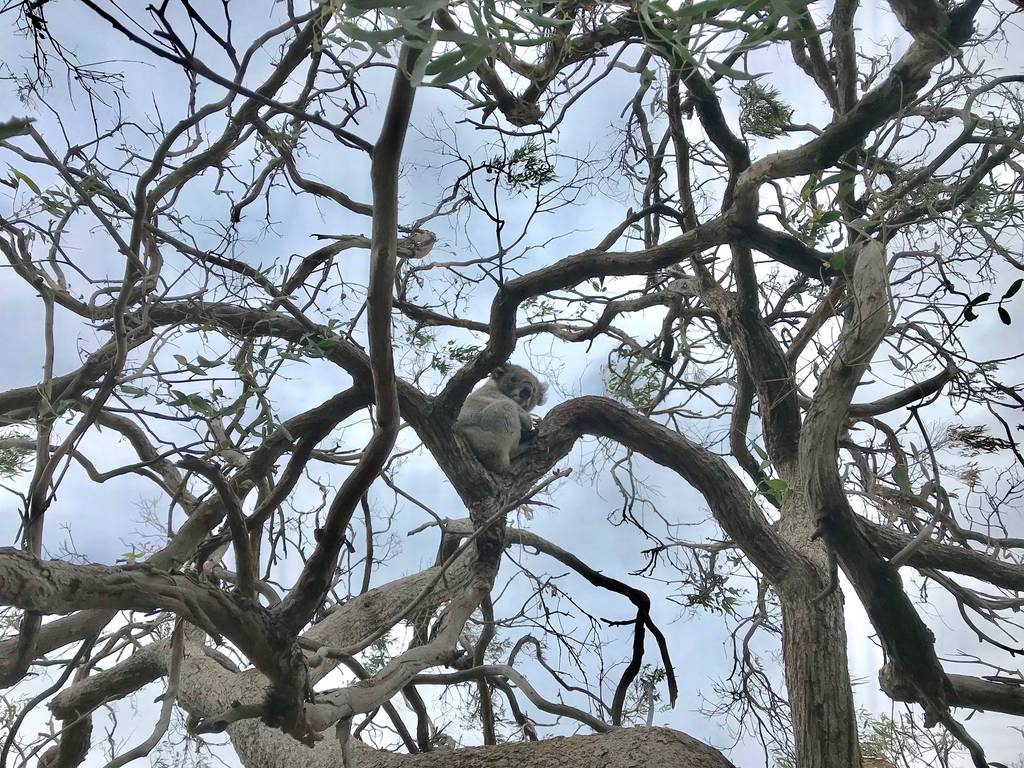
Barbara blogs at Let’s Go Mum .
Learn more about Asia’s wildlife . Check out Wildlife of Southeast Asia and Beyond the Last Village: A Journey of Discovery in Asia’s Forbidden Wilderness.
And don’t forget Australia’s unique wildlife: Wildlife of Australia and Watching Wildlife Australia : by Lonely Planet
This isn’t an exhaustive list of the best places to see wildlife in Asia and Australia . These books, Wildlife adventures in Africa and Wildlife Encounters in the Americas and Antarctica are also packed with amazing animals!
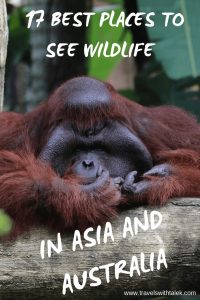
BTW, if you are getting ready for your trip, make sure to take advantage of these useful, money-saving links to book your trip:
- Research and book your flight with Skyscanner . I have found them to be the best because they list all airlines including the budget ones. You are always sure of having researched all options.
- For car rental around the world, Discover Cars has flexible pickup and drop-off options, I recommend Discover Cars .
- Book your accommodation with Booking.com . I find they have a wide selection and a nice, user-friendly, transparent website.
- Protect your trip and, more importantly, protect yourself with travel insurance. I use Travelinsurance.com and have been very happy with them.
- Looking for a small group tour to unforgettable destinations with top professionals? Intrepid Trave l is your choice.
- For more general tours to any destination or attraction, book with Viator . Check them out.
- Need a visa? Get your visa for all countries with Passport Visa Exp ress.
- Looking for a cool walking tour to explore a city? My favorite walking tours are offered by Take Walks.
- Food and drink tours are the best way to enjoy a city. And Devour Tours are my favorite.
- Looking for a good VPN to protect your security, privacy and freedom online while traveling? Nordvpn is your best option.
- The best and most economical way to stay connected while traveling is with an Airalo eSIM.
I personally use, and can recommend, all the companies listed here and elsewhere on my blog. By booking through these sites, the small commission we earn – at no cost to you – helps us maintain this site so we can continue to offer our readers valuable travel tips and advice.
Talek Nantes
7 thoughts on “17 best places to see wildlife in asia and australia”.
I’ve been lucky enough to see quite a few of these but have added the missing ones to my list : )
Nice checklist of wildlife places in Asia and Australia. India alone is home to 50 tiger reserves and Bandipur National Park is one of the best forests to spot tigers.
Sounds like a fascinating place. Glad you liked the post.
Being a wildlife enthusiast I found your pick of list quite helpful and exciting. I’m gonna add some places you mentioned to my visit list. Really liked your article and glad to know your experience of Karnataka,India. I have been to Bandipur and Madumulai, my experience of Bandipur was better. Please do an article for African wildlife too. Thank you for sharing and keep up the great work.
Thanks for the nice comments. I’m glad you liked it. There is also a post on African wildlife on the site.
Great list of Asia wildlife preserves. Indonesia is my home country and I always wanted to visit Komodo National Park!
I’m also an aspiring writer and noticed you just published a book.. congratulations! It’s a great accomplishment.
Oh, how kind of you to say those nice comments. Thank you so much for taking the time to read and comment. So glad you enjoyed the post.
Leave a Comment Cancel Reply
Your email address will not be published. Required fields are marked *
This site uses Akismet to reduce spam. Learn how your comment data is processed .

Disclosure: As an Amazon Associate I may earn from qualifying purchases. Posts may contain affiliate links. If you click on one of them, we may receive a commission at no cost to you.

JOIN OUR NEWSLETTER

Lets Connect
Privacy policy.
Asia Wildlife & Safari Trips
- Start Date Select Month April 2024 May 2024 June 2024 July 2024 August 2024 September 2024 October 2024 November 2024 December 2024 January 2025 February 2025 March 2025 April 2025 May 2025 June 2025 July 2025 August 2025 September 2025 October 2025 November 2025 December 2025 January 2026 February 2026 March 2026 April 2026 OR, More specific start
- Easy Active
- Challenging
- Food & Wine
- Most Popular
- River Cruises
- Scheduled Group Tour
- Solo Travel
- Wildlife & Safari Exploration
- Archaeological Site Visits
- Cooking Classes
- Festival Visits
- Helicopter Tours
- Land & Sea Exploration
- Local Market Visits
- Rainforest Exploration
- Scuba Diving
- Small Ship Cruises
- Small Ship Sailing
- Spa Relaxation
- Stand Up Paddle Boarding
- Urban Exploration
- Village Visits
- Volunteering
- Whale Watching
- Whitewater Rafting
- Wilderness Lodge Exploration
- Wildlife Viewing
- Aqua Mekong
- Coral Geographer
- Emerald Harmony
- Heritage Adventurer
- Le Commandant Charcot
- Le Jacques Cartier
- Le Laperouse
- National Geographic Orion
- National Geographic Resolution
- Ombak Putih
- Paul Gauguin
- RV Angkor Pandaw
- RV Bassac Pandaw
- RV Indochine
- RV Indochine II
- RV Katha Pandaw
- RV Kindat Pandaw
- RV Laos Pandaw
- Scenic Eclipse II
- Scenic Spirit
- Sylvia Earle
Culture & Wildlife of Southern India
- Visit the magnificent Mysore Palace
- Explore Nagarhole National Park
- Enjoy wildlife in Bandipur National
- Watch farmers in the plantation
Culture & Wildlife Journey of India
- Explore the ruins of Old Delhi
- Ride in 4x4 open safari jeep
- Visit Khajuraho temples
- Witness religious rituals
- Visit Amber Fort in Jaipur
- See Picturesque Taj Mahal
Borneo Wildlife Safari
- Stay at Sukau Rainforest Lodge
- See pygmy elephants and orangutans
- Explore the jungles of Borneo
- Cruise the Kinabatangan River
Best of Nepal
- Visit UNESCO sites in Kathmandu
- Discover ancient temples and bazaar
- See monks local way of life
- Explore Pokhara's hidden gems
- Visit Phewa lake
- See wildlife in Chitwan
- See wildlife and their habitat
Hidden Gems of Rajasthan
- Explore ruins of Old Delhi
- Ride on a safari 4x4 open jeep
- Tour Mehrangarh Fort
- Stay in Jawai Jungle Camp
Wildlife of Central India
- View wildlife at Bandhavgarh
- Ride in a safari 4x4 open jeep
- Visit Kanha National Park
- Watch the wildlife in Satpura
Discover Southern India
- Visit Shree Meenakshi Temple
- Explore Periyar National Park
- Explore the French Quarter
- Watch farmers harvest peppers
Discover Kerala with Houseboat Stay
- Explore Cochin
- Watch Kathakali dance performance
- Nature walk in the tea plantation
- Discover Kerala in a houseboat stay
Kaziranga National Park Extension
- Visit Kaziranga National Park
- Witness the jungle in a 4x4 jeep
- Stay in wilderness lodge
- Spot the famous one-horned Rhinos
Kanha National Park Extension
- Ride in a 4x4 jeep safari
- Stay in a jungle lodge
- Watch the documentary Tigerland
The Scents of the Spice Islands
- Visit Hitu Lama
- Snorkel over black lava stream
- View production of sago
- Trek towards a forest waterfall
- Borneo Hiking & Wildlife Adventure
- Summit Mount Kinabalu
Borneo Big Five Wildlife Expedition
- Discover Orangutans at Sepilok
- Learn Sun Bears
- Experience Gomantong Cave
- Join river cruises
In the Wake of the Makassans
- Encounter funeral rituals
- Gaze out Kelimutu National Park
- Walk in tracks of Komodo Dragons
- Hike to the summit of Padar Island
- Explore Takabonarate Marine Park
Sri Lanka Wildlife
- Visit Negombo's fish markets
- Explore Gal Oya Lake by boat
- Walk the historic streets of Galle
- Spot majestic elephants in the wild
Papua's Whale Sharks and Birds of Paradise
- Swim under Kitikiti waterfall
- Explore the maze of karst islands
- View birds of paradise in nature
- Enjoy the isolated Ceram Sea
Kimberley Expedition: Northwest Australia & Indonesia
- Explore King George river
- Discover the unique wildlife
- Visit the Komodo National Park
- Experience Indonesia
Highlights of Sri Lanka
- Ride bikes in Mankandura
- Visit the fortress of Sigiriya
- Learn the colonial history of Kandy
- Look for elephants in Yala
Asia Travel Guide
- All Asia Trips
- Asia Cruise: When to Go?
- Best Times to Visit Thailand
- Best time to Visit Cambodia
- Asia Luxury Tours
- Mekong River
Favorite Asia All Trips
- Great Wall, Dynasties, & Rivers
- Beautiful Beijing & the Wall
- Best of Thailand
- Vietnam Adventure
- Highlights of Cambodia
- Essence of China
Top Asia Travel Destinations
- Myanmar (Burma)
- Russian Far East
- South Korea
Asia Trips by Departure Date
- 2024 Asia trips (218)
- 2025 Asia trips (195)
- 2026 Asia trips (66)
- August 2024 (138)
- September 2024 (139)
- October 2024 (166)
- November 2024 (173)
- December 2024 (154)
- January 2025 (136)
- February 2025 (133)
- March 2025 (133)
- April 2025 (125)
Top Experiences in Asia
- Asia Cruises (122)
- Asia Cultural (96)
- Asia Land Tours (94)
- Asia River Cruises (58)
- Asia Luxury (38)
- Asia Active (26)
- Asia Beaches (25)
- Asia Wildlife & Safari Exploration (22)
- Asia Trekking (17)
- Asia Most Popular (9)
- Asia Family (8)
- Asia Food & Wine (5)
Asia Trips by Duration
- 5 day trips (27)
- 6 day trips (9)
- 7 day trips (10)
- 8 day trips (31)
- 9 day trips (12)
- 10 day trips (17)
- 11 day trips (15)
- 12 day trips (19)
- 13 day trips (15)
- 14 day trips (10)
- 15 day trips (8)
- 16 day trips (9)
- 17 day trips (5)
- 19 day trips (3)
- 20 day trips (3)
- 25 day trips (4)
Asia Trips by Activity
- Asia village visits (149)
- Asia local market visits (112)
- Asia small ship cruises (94)
- Asia wildlife viewing (81)
- Asia snorkeling (56)
- Asia archaeological site visits (54)
- Asia hiking (44)
- Asia urban exploration (38)
- Asia kayaking (31)
- Asia cooking classes (30)
- Asia biking (29)
- Asia wilderness lodge exploration (20)
- Asia rainforest exploration (17)
- Asia land & sea exploration (11)
- Asia spa relaxation (11)
- Asia homestays (11)
- Asia stand up paddle boarding (10)
- Asia camping (6)
- Asia whale watching (5)
- Asia scuba diving (5)
- Asia volunteering (3)
Why Travel With Adventure Life
Recognized by.

National Geographic content straight to your inbox—sign up for our popular newsletters here

At Elephant Valley Thailand, in Chiang Rai, tourists are instructed to observe the animals from a safe distance.
What I learned investigating the wildlife tourism industry
I traveled the world documenting unseen suffering. Here’s what you can do to respect animals during your travels.
Right away, Elephant Valley Thailand felt different. The property, nestled in the forest on the outskirts of Chiang Rai, a small city in northern Thailand, was the fifth elephant attraction I’d visited in a week. I’d seen shows where elephants kicked soccer balls and twirled hula hoops. I’d watched people ride on their backs and swing from their trunks. I’d peeked into the stalls to which elephants returned after working, where they’re chained by their ankles to posts.
But Elephant Valley was quiet. It was the first time all week that I’d seen elephants from a distance. One was bathing in a pond, alone. Another two were eating in the middle of a field. Wooden fences surrounded most of the fields—to keep us out, not them in, John Lee, a manager at Elephant Valley, told me. That’s what struck me most: No one was allowed to touch the animals. These were elephants being elephants. ( Here's why we're shining a light on wildlife tourism. )

Elephant Valley Thailand ”was the most responsible elephant sanctuary that we visited,” says author Natasha Daly.
Elephant Valley Thailand, home to five elephants that previously worked in trekking camps and the logging industry, is unlike most other elephant attractions in Thailand. Many of the country’s 3,800 captive elephants live in camps that offer up-close, interactive experiences that allow visitors to ride or bathe the animals or watch them perform in shows. The activities are a massive draw for travelers from around the world, part of a lucrative global industry that puts people together with exotic animals for once-in-a-lifetime encounters.
It’s what brought me to Thailand , a monthlong stop on a reporting trip for National Geographic magazine that took photographer Kirsten Luce and me to four continents over a year and a half. Our goal was simple: to look at the animals that entertain us and the people who seek them out. Those people are you and they’re me. I have a photo of myself at two years old, perched on an elephant’s back at a zoo in my hometown of Toronto , Canada. Eight years ago, on my honeymoon, I went swimming with captive manta rays in Mexico . But seven years later, while reporting the story, I found myself watching a group of tourists pass around a tiger cub after paying a couple of dollars to feed him a bottle of milk—and wondering if anyone else was questioning why he wasn’t with his mom.
It’s complicated. People love animals and naturally want to get close to them—and genuinely want to learn more about them too. It’s a desire that’s increasingly fueled by social media, where travelers share their experiences instantaneously. The reality that many tourists don’t see is that to stay in business, elephant interactions—and photo ops with tigers and swimming with manta rays—rely on a steady stream of working wild animals, all of which have been caught or bred or trained into submission.
Related: 10 animals to see on a Botswana safari

And it’s all too easy to misread signs of suffering. Captive elephants sway their trunks back and forth—almost as if they’re dancing. In reality, it’s a sign of psychological distress. Sloths seem to love cuddling, but their hug is really just an attempt to cling to what feels to them like a tree trunk. Dolphins appear to be smiling but that’s the natural set of their mouths.
Travelers are increasingly recognizing that many animal tourist attractions may not be ethical. More and more backpackers are shunning elephant riding. ( Follow these tips for ethical animal encounters. )
The industry knows it. Dozens of properties in Thailand now call themselves “sanctuaries.” Many look a lot like Elephant Valley and boast five-star ratings on travel sites such as TripAdvisor . But Kirsten and I found that, unlike Elephant Valley, almost every one offers elephant bathing for visitors who wish to splash with an elephant in a river or mud pit. Often the bathing is repeated all day long. And only trained elephants will submit to baths.
Jack Highwood opened Elephant Valley in 2016. The 40-acre property is his second elephant sanctuary, following a much bigger one he established in Cambodia. He chose to go small with the Thai sanctuary, installing inexpensive wooden fencing and minimal infrastructure because he wanted to make the model as easy as possible for others to copy. It felt peaceful, several visitors at Elephant Valley told me. As if the elephants didn’t even know they were there.
While traveling the world, I spoke to tourists everywhere. In restaurants and hostels. At aquariums and monkey shows. I would often ask people if they prefer to have an up-close experience with an animal in captivity or observe it from afar in the wild. More often than not, they told me the latter. Yet captive encounters remain extremely popular. Maybe because an animal sighting is assured. Maybe because the animals seem happy, and it seems that your admission fee is going to contribute to someone’s paycheck. Maybe, perhaps most compelling of all, because it gives you a photograph—you, together with an exotic animal—that can go straight to your social media feed, where likes and comments are guaranteed.
Across the Pacific, on the North Shore of Oahu, in Hawaii , there’s a beach called Laniakea. People more commonly call it Turtle Beach, because sea turtles regularly come ashore. They’ll pick a spot and sleep in the sun, sometimes for hours at a time. Volunteers are there every day to keep people away from the animals. When a turtle emerges from the sea, the volunteers block off space for it with rope, giving the turtle ample room to relax in peace.
One weekday in September, I sat with dozens of tourists behind the rope and watched them watching a turtle. For the most part, people were respectful. A few asked why they couldn’t touch. It’s illegal to touch sea turtles in Hawaii, the volunteers explained. And it’s important to respect their space, they added. This is their beach too, after all.
It can be hard for most people to tell the difference between ethical and problematic wildlife experiences. There are many shades of gray. But you might follow a few simple guidelines :
Keep your distance. Seek experiences that offer observation of animals engaging in natural behaviors in natural environments.
Do your research. A highly rated place may not necessarily be humane. Read those one- and two-star reviews. It’s often in the pans that visitors chronicle animal welfare concerns.
Beware of buzzwords. A facility may use phrases on their website or promotional materials such as “gives back to conservation,” “rescue,” and “sanctuary,” but if it still offers extensive interaction, that may be a red flag.
- Nat Geo Expeditions
Related Topics
You may also like.

See Kenya’s wildlife in a different light: on horseback

Inside the newest park in Argentine Patagonia
Free bonus issue.

How I got the shot: Jonathan Gregson on witnessing Uganda's wallowing hippos

Winter vacations don't have to be about snow—check out these perfect getaways

Bear Grylls reveals his top travel tips
5 of alaska’s ultimate wildlife adventures.

The Cool List 2024: the 30 most exciting destinations to visit in 2024
- Environment
- Perpetual Planet
History & Culture
- History & Culture
- History Magazine
- Mind, Body, Wonder
- Paid Content
- Terms of Use
- Privacy Policy
- Your US State Privacy Rights
- Children's Online Privacy Policy
- Interest-Based Ads
- About Nielsen Measurement
- Do Not Sell or Share My Personal Information
- Nat Geo Home
- Attend a Live Event
- Book a Trip
- Inspire Your Kids
- Shop Nat Geo
- Visit the D.C. Museum
- Learn About Our Impact
- Support Our Mission
- Advertise With Us
- Customer Service
- Renew Subscription
- Manage Your Subscription
- Work at Nat Geo
- Sign Up for Our Newsletters
- Contribute to Protect the Planet
Copyright © 1996-2015 National Geographic Society Copyright © 2015-2024 National Geographic Partners, LLC. All rights reserved

Sustainable Wildlife Tourism in Asia and the Pacific: UNWTO report
May 1, 2020 | News | 0 comments
UN’s World Tourism Organisation last year commissioned Professor Noel Scott (who subcontracted WTA chair Dr Ronda Green as co-editor, with UNWTO’s approval) to put together a report on good practice examples of sustainable wildlife tourism in Asia and the Pacific. After many months that report is now available as a free downloadable pdf. Dr Scott is a WTA member, as are several others who assisted with authoring chapters, reviewing or providing information.
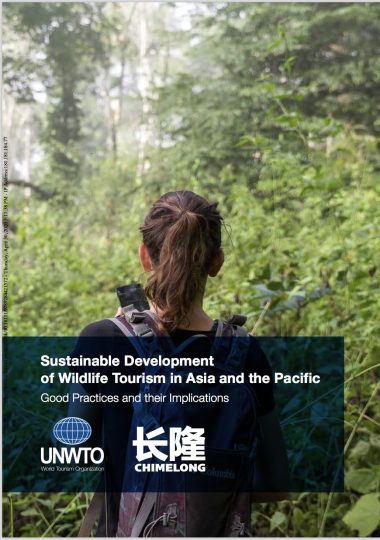
World Tourism Organization and Guangdong Chimelong Group (2020), Sustainable Development of Wildlife Tourism in Asia and the Pacific : Good Practices and the Implications. UNWTO, Madrid, DOI:
https://doi.org/10.18111/9789284421572
Published: April 2020 Pages: 136 eISBN: 978-92-844-2157-2 | ISBN: 978-92-844-2156-5
From their website:
“ Set within the framework of the UNWTO/Chimelong Initiative, this report illustrates 13 good practice cases in wildlife tourism. A further 5 snapshots are examined briefly to illustrate the breadth and importance of wildlife tourism across Asia and the Pacific.
In order to reflect the diversity in both geographical scope and market segment of the sector, a variety of operations were selected including examples from the private sector, the accommodation and transport sectors, as well as from visitor attractions. At the same time, the report offers a range of examples of tourism being used to safeguard habitats and species, both terrestrial and marine.
While the rapid growth of the sector is noted and important components of wildlife tourism are discussed, this report aims to highlight the positive impacts resulting from the implementation of sustainable policies and practices within the wildlife tourism sector in Asia and the Pacific. It examines only non-consumptive forms of wildlife tourism (no hunting, fishing or collecting) and concentrates on the viewing of wild “
Submit a Comment Cancel reply
Recent posts.
- Japanese Wildlife Tourism forum
- Wildlife Tourism Workshop Sydney 20 July
- Australia-Indonesia Tourism Resilience Program
- Encouraging Children to experience Nature
- Photos from WTA Conference 2022
- Christmas Island – Australia’s Gem In The Indian Ocean
- Managing Wildlife Watching Tourism: Seal Watching in Iceland

20 Famous Wildlife Sanctuary and National Park in the Asia

The rapid growth of safari tourism in Asia can be attributed to the increasing availability of the continent’s many national parks, safaris, and wildlife reserves to visitors worldwide. The thought of going on a safari through these thick forests, which are home to such endangered species, will undoubtedly get your heart racing.
There are many one-of-a-kind animals that can only be seen in India, such as the Asiatic lion, Bengal tiger, snow leopard, and one-horned rhinoceros. Below is the compilation of the list of the top wildlife safari places in Asia, including the best guide to Asia Wildlife Sanctuary and National Park.
Table of Contents
List of the Top 20 Popular Wildlife Sanctuary and National Parks in Asia:
1. chitwan national park, nepal.

Out of all the wildlife sanctuaries and national parks in Nepal , Chitwan National Park is the first and oldest. UNESCO has designated this as a World Heritage Site.
Between the months of October and December, visitors to Chitwan National Park have the highest opportunity of seeing tigers, wild boar, and other wild creatures as they emerge from their dens. The huge creature appeared to be in distress. A tiger walks past a settlement outside Bardia National Park.
2. Bandhavgarh National Park, India

Eagles can be found in habitats that combine grassland, Sal trees, and tropical forest. this park is a well-known sanctuary in India, and its popularity among travellers has only grown over the years. Read Also: 10 Famous Things to Do in Bandhavgarh .
The Umaria district of Madhya Pradesh is home to a national park with three distinct safari zones: Tala, Magdi, and Bamera. Tala Zone assures you of more tiger sighting moments. There are high chances of witnessing gorgeous Indian tigers, leopards, and sloth bears. Also, read How to Reach Bandhavgarh National Park
- Delhi Agra Jaipur Khajuraho Package
- Khajuraho & Bandhavgarh Trip
- Gujarat with Madhya Pradesh Itinerary
- 3 Days Khajuraho Travel Package
- Pachmarhi Tour 3 Days from Nagpur
3. Sagarmatha National Park, Nepal

Sagarmatha National Park is well-known not only for its aesthetic value but also for the religious and cultural significance it holds.
The Himalayas are home to a wide variety of wildlife, including black bears, goats, and weasels. Visit Sagarmatha National Park in the months of March or May, October, and November, for the best weather.
4. Gir Forest National Park, India

The world-famous Asiatic lions can only be found in Gir Forest National Park, a wildlife sanctuary in the Indian state of Gujarat. In 2015, there were over 500 lions living in Gir National Park, where you may see the royal lions wandering freely in the wild.
Deer, hyenas, snakes, leopards, and crocodiles are just some of the numerous creatures that call the national park home. Every year, from October 16th to June 15th, visitors can enjoy Gir National Park.
- Gujarat Travel for 9 Days
- 5 Nights 6 Dyas Gujarat Trip
- 3 Days Gir National Park Tour
- 7 Days Gujarat Diu Package
- Gujarat Tour for 5 Days
- Check Gujarat More Itineraries
5. Koshi Tappu Wildlife Reserve, Nepal

Located in the Terai region of eastern Nepal, the Koshi Tappu Wildlife Reserve was established to save the country’s dwindling population of wild water buffalo.
More than 450 different bird species have made this wildlife reserve a paradise for bird enthusiasts. The reserve is home to a wide variety of other animals besides birds, including crocodiles, deer, and spotted hogs.
- 9 Nights 10 Days Nepal Trip
- Nepal Itinerary for 6 Days
- 5 Days Nepal Tour Package
- Kathmandu & Pokhara Tour
- North India with Nepal Package
- Nepal With Rajasthan Itinerary
- Check More Packages for Nepal
6. Bhutan’s Royal Manas Park, Bhutan
The Royal Manas Park in Bhutan was the first national park in the country. Among the best national parks in Asia, Royal Manas was the subject of Bhutan’s first park management plan and is at its best from November through March.
Over 365 different kinds of birds have been identified so far. Great white-bellied herons and rufous-necked hornbills, both of which are in peril, can be seen in the park.
7. Umphang Wildlife Sanctuary, Thailand
This western Thai forest serves as the seedbed for a larger forest that is a World Heritage site recognized by UNESCO. Located in a tropical rain forest 900 meters above sea level lies the massive Thi Lo Su Waterfall, built of limestone.
The locals claim that the waterfall is at its most stunning between the months of June through November when heavy water flow makes for pleasant temperatures.
8. Khao Kheow Open Safari, Thailand

More than 8,000 animals, representing more than 300 different species, call Thailand’s first zoo, Khao Kheow, home. The Khao Kheow open safari is a popular attraction in Thailand and for good reason.
There are numerous options for travel that I’ve outlined above. Take advantage of the complimentary tram rides and make stops at each station to see the animal presentations without having to trek around the park.
- 7 Days Thailand Travel Itineraries
- 4 Days Bangkok Pattaya Tour
- Phuket 3 Nights 4 Days Travel
- Thailand Package for 8 Days
- 6 Dyas Thailand Itinerary
- Check More Itineraries for Thailand
9. Sakteng Wildlife Sanctuary, Bhutan

In addition to being a haven for the flora and animals of Bhutan , this sanctuary is also home to the country’s remote nomads.
A sanctuary is a great place for birdwatchers, since several species of birds may be seen there, including the Assamese macaw, blood pheasant, and grey-headed woodpecker.
10. Kanha National Park, India

When talking about places to see tigers in Asia, Kanha National Park is always mentioned as a top choice. Tiger Safari Tours makes it simple to see the sights and hear the sounds of the park’s four distinct ecosystems.
You can choose to go on a tour in the morning and see the sunrise or in the afternoon and return at sunset. Read Also: Top 9 Wildlife National Parks in Madhya Pradesh .
11. Jim Corbett National Park, India

The Jim Corbett National Park is named after the famed tiger hunter who became a naturalist. Jim Corbett National Park is home to a thriving tiger population, making it a prime location for tiger sightings, and visitors are welcome to spend the night at the park’s Dhikala forest lodge. Read Also: 6 Famous Safari Zones in Jim Corbett National Park .
- 2 Nights 3 Days Corbett Tour from Delhi
- Corbett 2 Nights 3 Days Tour with 2 Jeep Safaris
- Nainital with Jim Corbett 3 Nights Tour Package
- Dhikala Tiger Tour 1 Night 2 Days
12. Ranthambore National Park, India

Snow leopards, Royal Bengal tigers, blue sheep, Himalayan black bears, and red pandas are just a few of the rare animals that call the sanctuary home.
You can also take in the beautiful scenery of the park’s many rivers, streams, glaciers, and glacial lakes while out on your wildlife-spotting trip. Check out the 10 Popular Tiger Safari Zones in Ranthambore National Park .
- Ranthambore 2 Nights 3 Days Wildlife Tour
- 2 Nights 3 Days Ranthambore Trip Itinerary
- Ranthambore National Park Itinerary by Train
- 9 Days Golden Triangle Tour With Ranthambore
13. Wangchuck Wildlife Sanctuary, Bhutan
The Wangchuck Wildlife Sanctuary is Bhutan’s largest national park and was designated as such in 2008. The park is rich with flora and fauna that are not commonly seen in other regions of the world, and it is particularly famous among hikers because of the park’s abundance of high mountains.
14. Bumdeling Wildlife Sanctuary, Bhutan

Bhutan’s famous black-necked cranes spend the winter at this sanctuary, which is located in the district of Trashiyangste.
In addition, the sanctuary is home to other important religious and cultural sites, including the mystical Singye Dzong and the Dechen Phodrang Lhakhang.
- 6 Nights 7 Days Bhutan Travel
- Bhutan Package for 6 Days
- 4 Nights 5 Days Bhutan Tour
- Bhutan Itinerary for 8 Days
- Click Bhutan More Packages
15. Huai Kha Khaeng Wildlife Sanctuary, Thailand

Thailand is advertising not only its rich cultural history but also has many opportunities for wildlife tourism, like the Huai Kha Khaeng Wildlife Sanctuary.
Due to the reserve’s relatively unobstructed forest, spotting wildlife is a breeze. The sanctuary houses the country’s greatest tiger population in addition to other species including elephants and leopards.
16. Kaeng Krachan National Park, Thailand

The Kaeng Krachan National Park is the largest of Thailand’s national parks and is recognized as a cultural treasure by the Association of Southeast Asian Nations (ASEAN).
For the sake of visitor safety and forest regeneration, several areas of the park are closed throughout the months of August through October. The park is primarily covered by a mountainous forest that is home to over 200 species of birds and 57 species of mammals.
17. Thailand’s Khao Yai National Park

It features one of the highest hornbill populations in the country and is home to roughly 300 different species of birds year-round. Unquestionably, this is the best spot for bird watching imaginable.
There are a variety of mammalian species present in the park, but no tigers. March and April are prime seasons for a trip to the national park.
18. Sri Lanka’s Yala National Park

As Sri Lanka’s second-largest national park, Yala is a must-see destination . Because of its proximity to the Indian Ocean and its status as a wildlife refuge since 1900, it is the most popular national park in the country.
Sri Lanka grey hornbills, Sri Lanka wood pigeons, black-necked storks, flamingos, pelicans, egrets, Indian peafowls, and black storks are just a few of the birds that can be seen here. This national park is home to a wide variety of mammalian species. Also, read Top 10 Famous Wildlife Places in Sri Lanka
- 10 Days Sri Lanka Trip Itinerary
- Sri Lanka 8 Days Package
- 6 Nights 7 Days Sri Lanka Tour
- 5 Days Sri Lanka Tour Package
- Check Srilanka More Travel Itineraries
19. Indonesia’s Komodo Islands and Park

There are a total of 26 islands inside Komodo National Park, as well as the three main islands of Komodo, Padar, and Rinca. It was established in 1980 to safeguard the Komodo dragon, and is now a UNESCO World Heritage Site.
The Komodo dragon may be the best-known “resident,” but it is joined by a wide variety of other fascinating creatures in Komodo National Park.
20. Foping National Nature Reserve, China

If you’re looking for a national park that will make you go “awwww”, look no further than Foping Nature Reserve, where you can see giant pandas in their natural habitat. The reservation was established in 1978 specifically to safeguard these amazing animals.
21. Gunung Mulu National Park, Malaysia

Caves and karst structures in a hilly equatorial rainforest are included in this UNESCO World Heritage Site. The park’s caves and the expeditions launched to examine them and the surrounding jungle are its claims to fame; the Royal Geographical Society Expedition of 1977–1978, for example, spent 15 months in the park with more than 100 scientists.
More Information regarding Travel to Asia is Available
- 10 Places in Asia to See in October 2023
- Asia’s 10 Most Famous Luxury Hotels Stay
- Top 10 Dangerous & Highest Waterfalls in Asia
- Asia 10 Budget-Friendly Places to Visit
- 8 Most Popular Religious Destinations in Asia
- Asia Places to See During Christmas Celebration
- List of Most Popular Historical Sites in Asia
- 10 Places in Asia to Visit in November 2023
- 11 Most Famous Theme Parks in Asia
About The Author
Tusk Travel Team
Related posts.

Top 31 Places to Visit in Indonesia

7 Best Wildlife National Park in Rajasthan
Leave a comment cancel reply.
Your email address will not be published. Required fields are marked *
Save my name, email, and website in this browser for the next time I comment.

- South Africa
- The Ultimate Safari Planning Guide
- Safari Packing List
- Safari Luggage
- Safari Budget Guide
- Safari Reading List
- First-Timer’s Tips
- A Typical Day on Safari
Wildlife Travel In Asia
Though maybe not the most well known wildlife travel destination, Asia offers plenty of opportunities for animal lovers to spot wildlife in their natural habitats.
In Asia, you can explore jungles and rainforests on foot in search of primates and reptiles, while national parks make it possible to see big cats and Asian elephants in the wild from the comfort of jeeps and canters. The warm waters around Asia also give wonderful opportunities to spot whales and marine life on water safaris.
Asia wildlife holidays are as varied as the landscapes and habitats available on the continent, making it one of the most beautiful places in the world to spot animals.
Explore the guides below to find out more about the wildlife tourism available in Asia.
Asian Wildlife Destinations

Home to the world’s largest surviving population of tigers, India should feature on any wildlife lover’s bucket list. But that’s not the only reason why: this majestic animal shares its habitat with countless other species, including bears, elephants, leopards and monkeys. India’s vast national parks are spectacular, ranging from dense forests and jungles to mountains.

What Sri Lanka lacks in size, it certainly makes up for in beauty, warmth and, of course, places to see wildlife. The jungles and national parks of the teardrop island are a beautiful setting in which to spot elephants, monkeys and exotic bird life. If you’re really lucky, you may even come across a Sri Lankan leopard that, while being common, remains very elusive.
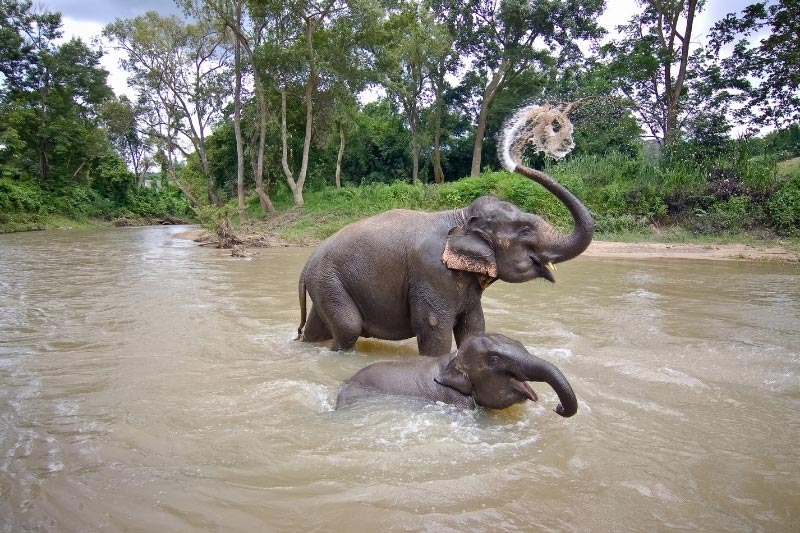
Thailand is a wildlife lover’s paradise. The jungles and rainforests of the north are home to dwindling numbers of wild elephants, while gibbons, geckos and various species of snake also call Thailand home. The waters around Thailand are studded with manta rays and whale sharks, meaning you’re never far from the wild when relaxing on a Thai island.

China’s vast size makes it large enough to cover a wide range of habitats, suitable for pandas to feast on bamboo in the forests of the southern and eastern provinces, as well as the dry, rocky mountain ranges that are cold enough to house snow leopards. China is also home to a large variety of other big cats, primates, ungulates and deer. You just need to know where to look!

As a tiny city state, you would be forgiven for believing there wouldn’t be much to see in terms of wildlife in Singapore. But, outside of the main urban sprawl, in the island’s nature reserves you’ll find a surprisingly diverse array of wildlife. Mammals including macaques and langurs roam the tree tops while snakes and lizards hunt for food along forest floors.

The National Parks and wildlife reserves of Nepal are just as spectacular as its mountains. In this part of Asia, you’ll find a huge variety of animal species including tigers, snow leopards, clouded leopards, foxes, elephants, rhinos, red pandas and pangolins. And that’s just the start! The diversity of flora, fauna and habitat in Nepal makes it one of the best places to see wildlife in Asia.
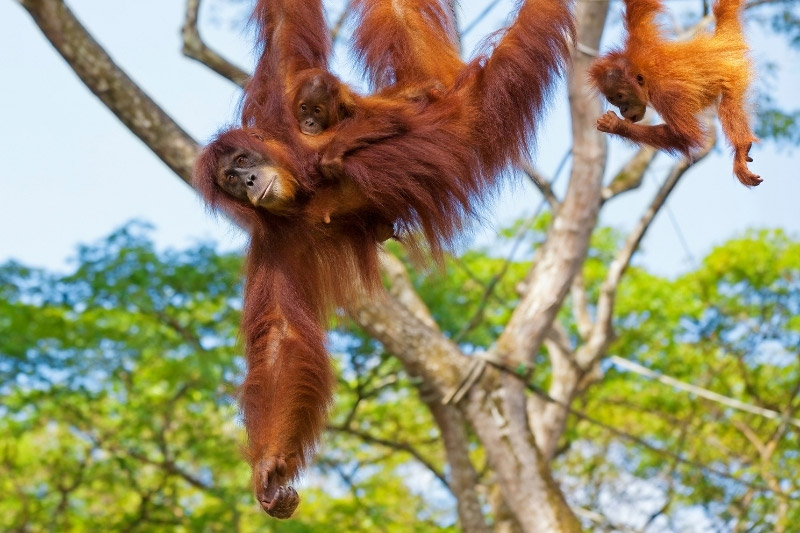
The southeast Asian island of Borneo is famous for its population of orangutans that swing through the tree canopies like something straight out of The Jungle Book. The tropical climate and habitat make an ideal home for a wide variety of wildlife, such as amphibians, reptiles, birds and primates as well as larger mammals including rhinos and elephants.

With most of the country covered in some of the world’s best rainforests, mainland Malaysia is a great place to see animals in the wild. The incredible list of predators calling Malaysia home include two species of tiger, two species of leopard as well as the sunbear. River safaris of the wetlands and mangroves of Taman Negara National Park are a unique way to spot impressive birdlife.

Japan’s bustling cities may make it an unlikely wildlife destination in Asia, but it is a deserving one. The best animal encounters here happen in winter, with opportunities to spot Japanese macaques warming themselves in hot springs, and Japanese cranes dancing in the snow. The rest of the year, the wetlands of Yatsu-Higata are a fantastic place to see migratory birds.
Asian Wildlife & Animals
Asian animals are as diverse as the habitats they live in.
The big cats that call Asia home are plentiful enough to rival Africa , with the addition of tigers, snow leopards and clouded leopards thrown in for good measure. But that’s not all – a huge variety of unique mammals, birds, reptiles and marine life live in Asia, making wildlife holidays more worthwhile than you may have previously thought.

The villain of the Jungle Book but the hero of a safari in Asia is the majestic tiger. Nothing can quite prepare you for your first sighting of their bright orange and black stripes peeking out through the undergrowth. Though their numbers are growing, you still need to be lucky to spot a tiger in the wild .
Giant Panda

The poster child for wildlife conservation, giant pandas are growing increasingly rare to see in the wild. But that’s what makes sightings of these adorable black and white creatures even more special. They live in the mountain ranges of China, and their diet mostly consists of bamboo shoots – up to 14kg of bamboo per day!
Snow Leopard

Though snow leopards are shy and reclusive, Asia is the only place you might spot them in their natural habitat. These big cats are covered in thick grey fur with black spots provide camouflage and also protect them from the harsh climates they live in across Asia’s highest mountain ranges.
Latest Asia Blog Posts

Where to See Tigers in the Wild
Tigers are some of the most beautiful creatures in the world, and seeing one in | Read more...
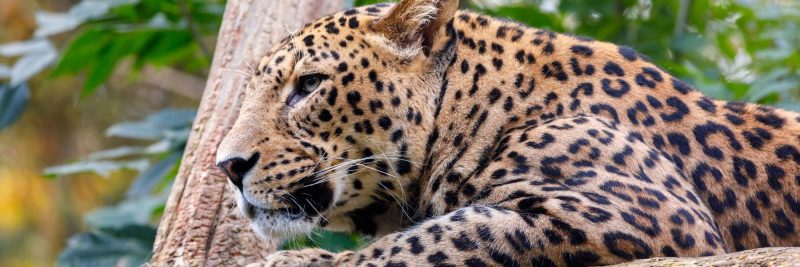
Where to See Leopards in Sri Lanka
If you’re a wildlife enthusiast, nature lover, or simply an adventure seeker, then Sri Lanka | Read more...
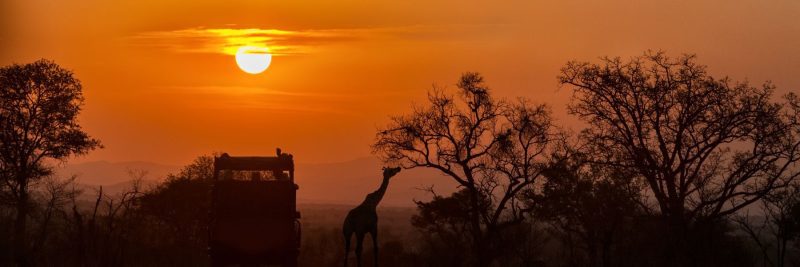
What is a Safari?
When we think of safaris, we often picture vast open savannahs, majestic wild animals, and | Read more...
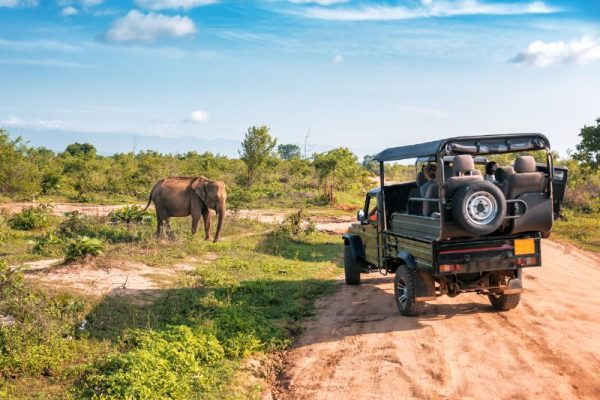
Sri Lanka Safari Planning Guide
Welcome to Sri Lanka, a tropical paradise known for its rich culture, stunning landscapes, and | Read more...

Ranthambore Travel Guide
Discover everything you need to know about seeing Indian animals in the wild in this | Read more...

Animals in India
When you imagine animals in India, you’ll likely remember the Bengal tiger and even the | Read more...
UN Tourism | Bringing the world closer
Wildlife conservation, unwto/chimelong.
- UNWTO/Chimelong Initiative
- WHY WILDLIFE?
- UNWTO/CHIMELONG ACTIVITIES
- INITIATIVE RESOURCES - CONTACTS
share this content
- Share this article on facebook
- Share this article on twitter
- Share this article on linkedin
UNWTO/Chimelong Initiative on Wildlife Conservation and Sustainable Tourism in Africa & Asia and the Pacific
- Asia and the Pacific
UNWTO/Chimelong Initiative are to contribute to the Sustainable Development Goals and the 2030 Agenda
Advocating the Sustainable Development Goals, enhancing the quality of human capital, encouraging the tourism private sector to adhere to corporate social responsibility and exploiting the potential for cooperation on conducting research to deliver solutions and advance ideas in the field of wildlife conservation and sustainable tourism. These constitute the areas of work of the initiative on Wildlife Tourism resulting from the partnership signed between the Wolrd Tourism Organisation (UNWTO) and the Guangdong Chimelong Group.

The traditional concerns of the World Tourism Organization on protection and conservation of wildlife are well-known. Research work such as ‘Towards Measuring the Economic Value of Wildlife Watching Tourism in Africa’ (UNWTO, 2015) have portrayed the potential of tourism as catalyst to increase awareness, to promote conservation and protection policies and to engage multiple stakeholders in this global cause.
Illegal trafficking, poaching and lack of knowledge about the potential of wildlife have been some of the factors that have put this unique animal and vegetal richness at risk.
The commitment of the World Tourism Organization upon this theme has been reinforced by the adoption in 2015 by the United Nations General Assembly of the International Year of Sustainable Tourism for Development 2017. The initiative, to be led by the World Tourism Organization, has been articulated by a global campaign joined by governments, private sector recipients and civil society, aimed at raising awareness, at bringing partners of different nature and at building common action around the need to apply more sustainable and responsible practices into the tourism sector.

The initiative started its implementation in 2017 and will run through 2021 (period extended due to COVID-19 pandemic). It has as major focus on wildlife conservation in Africa and Asia and the Pacific as wildlife acquires a global dimension in these parts of the world. The initiative includes approaches such as capacity building, media engagement, research and talent development and addresses multiple stakeholders like governments, tourism administrations, media, civil society and private sector.
Objectives of the UNWTO/Chimelong Initiative:

- Enhance the quality of human capital in sustainable tourism and wildlife conservation
- Exploit the potential for cooperation with special emphasis on conducting research to deliver solutions and advance ideas that will lead to sustainable tourism and wildlife conservation
- Encourage the tourism private sector to adhere to corporate social responsibility, especially in wildlife conservation
UNWTO/Chimelong Initiative areas of contribution:
- Activities related to the improvement of the quality of human capital
- Theme based research
- Activities related to advocating wildlife conservation
- Activities for establishing tourist information facilities on wildlife conservation
UNWTO/Chimelong Initiative areas of work:
- Asia & the Pacific
- Media Activities
CALL US 1300 059 686

PH: 1300 059 686

10 Best Destinations for Wildlife Safari in Asia
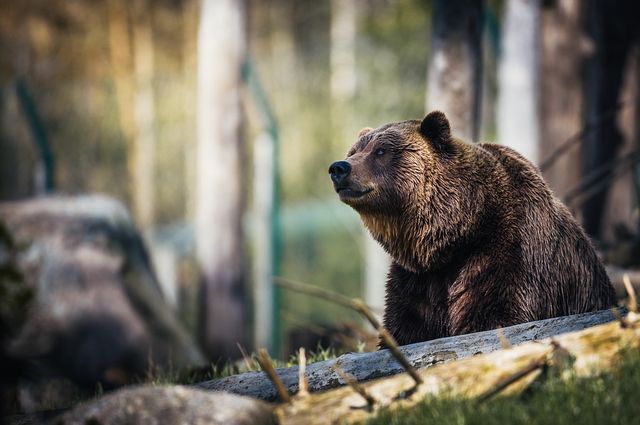
The outdoors is an exciting avenue to relax, sit back, and delight in nature’s wonders and marvellous wildlife.
Our gargantuan planet has every unique flora and fauna for all adventure seekers and animal lovers. And Asia, being the Earth’s largest and most populous continent, is definitely home to a one-of-a-kind wildlife.
People, along with government efforts, have protected Asia’s most well-known National Parks and Reserves to ensure a natural, uninterrupted habitat for these animals.
If you’re thinking of jumping on the next plane to Asia to experience the best wildlife safari of your life – pick from these top 10 best destinations for wildlife safari in Asia and prepare to be awestricken!
1. Cardamom Mountains, Cambodia
You will be dumbfounded by Indochinese tigers, clouded leopards, black bears, wild Asian elephants, and the roster goes on. The Cardamom Mountains wears one of the thickest rainforests in entire Southeast Asia. There are over 450 species of birds and the most unique one is the yellow-bellied warbler.
With so many flora and fauna species dissipating over time, the government and a number of local organisations have worked hand in hand to conserve the area. Efforts against logging, mining, and industrial development have taken place in recent years.
2. Komodo National Park, Indonesia
A country both rich in different cultures and delectable cuisine also boasts the giant lizards or “Komodo Dragons,” as what they’re otherwise known. These stunning giant lizards are only seen on this part of the island.
Although Indonesia is known to have months of downpour in a year; the Komodo National Park is one of the driest regions in the country. The best time to enjoy the beauty of Komodo Dragons is in the months of July and August.
3. Kanha National Park, India
The famous masterpiece, The Jungle Book, authored by Rudyard Kipling was created after this magnificent park. The author was inspired by its evergreen thick forests, meadows, ravines, and Kanha gorges. It is touted as the most picture-perfect wildlife park in Asia.
It is home to more than 200 species of plants and over 70 species of trees. Some of them are Lendia, Saja, Tendu, Palas, Aonla, and bamboo. Some birds are the pintails, pond herons, teals, peafowls, and egrets. While some of the unique animals are the barasingha and swamp deer.
4. Taman Negara National Park, Malaysia
Dive into a world of untouched rainforests and a roster of different wildlife like the rhinoceros, clouded leopards, tigers, Asian elephants, macaques, Chestnut-breasted malkohas, and thorny porcupines.
This destination is absolutely the place for wildlife watching and among some other outdoor activities are hiking and rock climbing. With a vast jungle of 4,343 square kilometres, it’s undoubtedly the largest park in Malaysia. The park encourages self-guided tours and the best season is from July to September.
5. Ba Be National Park, Vietnam
Nature lovers will be allured in the evergreen, lush forests of Ba Be National Park. This place is the country’s eighth national park with one of the lowest human impact. That means the wildlife here is in their natural habitat. The park is also sitting on a bed of limestone-rich soil.
Feast your eyes on animals you rarely see in your lifetime like the Vietnamese Salamander, Tonkin snub-nosed langur monkeys, Chinese pangolins, and red giant flying squirrels. Bats may also make it worth your while as there are as many as 18 varied species in massive caves!
6. Yala National Park, Sri Lanka
If leopards are your thing, prepare to be mesmerised by a myriad of Sri Lankan leopards as this park is a stomping ground for a large number of these animals. Dubbed as one of the largest and most popular parks in the country, there’s no way you should miss this on your next wildlife adventure.
This area is home to 32 species of mammals, 125 species of birds, and a couple of reptiles. Ride a jeep safari tour and you might get lucky and witness a juvenile bull elephant charge at you. But don’t worry, they’re extremely cute and harmless.
7. Umphang Wildlife Sanctuary, Thailand
Inhibited by the Karen people who also act as the tour guides, you can be sure your wildlife experience in this UNESCO-protected sanctuary is as raw and one-of-a-kind as it gets. Because it is located in the remote jungle of Thailand, this area is still not very popular to tourists.
But wait till you get to its most prized treasure – the ThiLor Su Waterfall. A breathtaking scenic view of towering limestone cliffs with powerful flows of water is best when visited from August to October.
8. Shuklaphanta Wildlife Reserve, Nepal
Nestled in the southwestern lowlands and blanketed by the Sal Forest; the Shuklaphanta is a vast and open grassland with a lot of waterholes. This setting is perfect if you want to see animals in their natural habitat drinking from the waterholes through safari tours. At the time of writing, there are only a few facilities for visitors as this area is still off the radar for tourists.
However, the extensive wildlife here is something a great adventure-seeker should never miss. Have a close encounter with the great one-horn rhinoceros, hog deer, barking deer, wild boars, royal Bengal tiger, golden jackals, striped hyenas, and more fascinating animals!
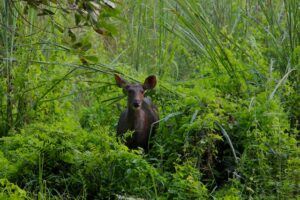
Deer spotted in Nepal’s national park
9. Gir National Park, India
Jeep safaris can definitely make your trip here well worth it in the end. Imagine yourself in an open-roof jeep, with the lions meandering in the background doing their business. This is one of the untouched wildlife areas in India. That’s why registering for a jeep safari still needs permission from the Sinh Sadan Forest Lodge Office. But the whole experience is heart-pumping and overwhelming at the same time.
10. Jigme Dorji National Park, Bhutan
Jigme Dorji National Park with an area of 4,349 square kilometers is the biggest protected area in Bhutan. You can feast your eyes on luscious forests, glaciers, and ice fields! Talk about getting the best of both worlds! The most prominent peaks are Jomolhari, Tsherimgang, and Jichu Drakey.
Different species like the Takin tiger, blue sheep, snow leopard, and red panda will catch you off guard during your wildlife exploration.
If you’re looking to add some fun and adventure in your usual travels, why not try out wildlife safaris instead? The intriguing and beguiling flora and fauna will surely make for an awesome and unforgettable trip!
Author Bio : Sarah Brooks is a passionate travel & outdoor blogger who loves to travel and write about her experience. She spends her free time hiking, swimming, camping and spending time with her family. She also blogs at GearJunior which is a site filled with outdoor tips and guides.
No Comments
Your email address will not be published.


Asia Nature & Wildlife Tours
Asia is our homeland. We'll show you Asia, better than anyone else!
- Philippines
- Culture & Highlights
- Food & Local Life
- Active & Nature
- Beach & Relaxation
- Couple & Honeymoon
- Family Holiday
- Luxury Hotels & Resorts
- Boutique Hotels
- Standard Hotels

Blessed with plenty of wildlife attractions (e.g., Kalimantan Island, Sumatra Island, Sabah, Sarawak, Danjugan and Bohol), a wide variety of terrain and the stunning landscape, Asia is a truly home to the most wonderful wildlife which you won’t find in many places on Earth. In our Asia Nature and Wildlife tours collection, you will have an amazing chance to meet some special animals such as Komodo dragons, tigers, orangutans, rhinos and much more. Besides, observing various tropical plants (e.g., palms, wonderful flowers and ferns) will offer you an insightful view of their natural habitats.
An Adventure To Remember In Indonesia
Since Indonesia has more than 17,000 pristine islands, you might feel a bit overwhelmed to pick your desired tour. Get ready to our best Indonesia Nature and Wildlife Tours collection which includes the most incredible wildlife places (e.g., Tanjung Putting, Komodo and Tangkoko National Parks) to get you closer to green nature by a wide range of unforgettable experiences.
Indonesia - Land Of Nature & Wildlife
We know the land of thousands of islands – Indonesia is a true paradise for adventure enthusiasts, especially who want to spend time to discover the most incredible and unusual animals from the long-tailed macaques of the Tanjung Puting National Park to the biggest lizard on Earth in the Komodo National Park. This is also home to hundreds of active and inactive volcanoes.
Plenty Of Unforgettable Experiences
For natural lovers, Malaysia is a true paradise for them to get man unforgettable experiences with nature and wildlife – Going deep into the lush tropical rainforest in Taman Negara National Park; making friends with many special animals like monkeys, orangutans, elephants and rhinoceros; watching turtles in Selingan Turtle Island and witnessing the colourful coral reefs and fish.
Broaden Your Knowledge About Natural Habitat
From plenty of exciting activities in our best Malaysia Nature and Wildlife Tours itineraries, you will get many chances to learn more about the natural habitat by visiting the most special national parks (e.g., Taman Negara, Gunung Mulu, Kinabalu and Bako national parks) and spotting some incredible plants and animals (e.g., gibbons, rhinoceros, leopards and monkeys).
Incredible Nature & Wildlife Spots In Philippines
The Philippines is popular amongst travellers for its some of the most beautiful beaches on Earth, incredible surfing spots, diverse marine, but this archipelagic country, which has over 7,200 islands, also possesses an abundance of nature & wildlife spots to take in - Puerto Princesa Subterranean River National Park, Banaue Rice Terraces, Chocolate Hills & Philippine Tarsier and Wildlife Sanctuary.
All Best Asia Nature & Wildlife Tours Recommended For You
Stress-free adventure Singapore, Thailand & Philippines
Asiatours expert.
We are here to help you
Travel from Thailand to Philippines on a excellently-built discovery, soaking up culture and revelling in the flavours of the regions. Take your time to discover a different side of Thailand, uncover flavours of energetic modern life in Singapore and idyllic islands in Philippines with soft white...
Dreamy Escape to Thailand, Vietnam & Malaysia Tour
The fascinating and varied itinerary will take you past from bustling cities of Bangkok, Hanoi and Ho Chi Minh city to the hauntingly picturesque Halong Bay, idyllic countryside of Mekong Delta, Chiang Mai and Karen villages, where you can enjoy friendly local hospitality at a homestay, and take in...
Unseen Nature and Rural Life of Laos
This eight-day tour will excite any visitors to Laos with its ethical elephant encounter, rustic river cruise, cave explorations, and more. The journey starts in Luang Prabang with an introduction to the historical, aesthetic, and spiritual significance of the laid-back town. Consider joining a...
Lesser Sunda Island Discovery Combine with Birding Tour
Find the beautiful birds in Indonesia! Our 16-day Lesser Sunda tour represents an enjoyable and fascinating adventure for those keen on exciting endemics and little-known creatures of this scenic region. Covering the hardcore birding destinations Flores, Komodo, Timor and Sumba, we offer a fresh...
Vietnam and Cambodia Bird Watching and Wildlife Tours
As its name, the tailor-made 16-day tour package is particularly designed for nature enthusiasts, especially those who are interested in in-depth birding and wildlife expedition. Unlike classic routes that mainly afford visits in major cities, you'll spend most of your time stay in Vietnam and...
- 1 Day Tours
- 2 - 5 Day Tours
- 6 - 10 Day Tours
- 11 - 16 Day Tours
- >16 Day Tours
Northern Thailand and Laos Highlights
Visit the most sacred and beautiful temples in Chiang Rai: White Temple, Blue Temple, Wat Phra Kaew
Immerse in the fresh air and peaceful hills scenery of Doi Mae Salong and Doi Tung
Enjoy 2-day cruise down stream Mekong River from Huay Xai to Luang Prabang
Discover the sacred Pak Ou caves housing approximately two thousands Buddha statues
Take an impressive city tour around quaint town of Luang Prabang
View the spectacular natural scene and soak in azure pools of Kuang Si Falls
Witness the daily morning alms giving, the most sacred tradition of Laos
Indulge in Vang Vieng's rustic and charming rural beauty
Visit series of highlighted caves in Vang Vieng: Elephant Cave, Snail Cave, Water Cave
Tour around Vientiane's key tourist sites including Wat Sisaket, That Luang Monument, Patuxai Victory Arch
Board on leisure cruise exploring islets, and local fishing villages on the Nam Ngum Lake

Bali and Komodo Adventure
Visit the series of Ubud's natural and cultural landmarks: Tegalalang Rice Terrace, Monkey Ubud Forest, Mt. Batur and Lake Batur, Tirta Empul Temple, Ubud Market...
Discover Bali's scenic cliff temple Uluwatu
Hop on a fascinating boat tour to Komodo and surrounding islands
Hike up for the beautiful panoramic pictures of Padar Island
Witness the giant lizard of Komodo Dragons in the natural habitat
Enjoy swimming and snorkelling on Indonesia's dreamy islands
Experience full-day tour in enchanting island of Nusa Penida by fast boat
See the amazing public performance of traditional Kecal Dance Performance

Best of Borneo
Stay at a long house of Dayak people and learn more about their culture as well as lifestyle
Meet incredible orangutans in their natural habitat and in the center of Borneo Orangutan Survival Foundation
Take a boat trip into the unique mangroves beside the Kahayan River
Enjoy some easy trekking in the forest behind Pilang village to explore the wildlife and local life
See the ancient Dayak painted sandungs and watch Dayak traditional dance
Explore Sebangau National Park by boating and trekking with many wildlife encounters
Visit Palangka Raya’s traditional market and Puntun village

Perfect Honeymoon in Sabah for Active Couple
Discover the diverse fauna and flora of the Kinabalu National Park
Directly spot the turtles lay their eggs, one of the most amazing wildlife moments, on the beach of Selingan Island
Explore the colorful marine life in Tunku Abdul Rahman Marine Park, one of Malaysia's best snorkelling sites
Challenging yourself with white water rafting in Kiulu River
Embrace the exotic Sabah's local culture through cultural village visit and exciting ethnic cooking class
Hands-on experiences about conservation in famous Sepilok Orang Utan Rehabilitation Centre
Dive into the pristine wildlife of Sadakan through safari cruises along the Kinabatangan River, spelunking, wildlife watching, and jungle trekkings.
Immerse in the lush vibe of Lahad Datu's forests, trek to a special ancient burial site of the local tribe then enjoy a bird's eye view of Danum Valley
Partake a guided tour and visit Sadakan City's famous sites
Enjoy the spectacular sunset and night entertainments on North Borneo Sunset & Dinner Cruise
Relax en route with hot springs and beautiful islands as well as have fun with the upside down house

Exuberant and Authentic Philippines
Get free time in El Nido town after your arrival or discover the beach area on your own
Hop on a boat adventure touring the best beaches of El Nido with a wide range of beach activities: swimming, snorkeling, kayaking,…
Relish your relaxing time in El Nido’s hot springs, beautiful beaches, or with your own ideas
Admire the extraordinary landscapes of Bohol’s Chocolate Hills and the stunning waterfalls of Pangas
Visit a tarsier sanctuary to see the world’s smallest primate as well as stop by a butterfly farm and the Bamboo Bridge
Enjoy a delicious local lunch on a floating restaurant in front of the Loboc River
Partake in Balicasag - Virgin islands hopping tour with a high chance of dolphin watching and plenty of beach time
Take an authentic island tour of Siargao to Magpupungko Natural Pools and picturesque local villages
Go island hopping to three tropical islands surrounding Siargao: Naked Island, Daku Island and Guyam Island

Borneo Photography Journey
Deeply immerse in the lush vibe of Borneo's forests through exciting walks
Spend all day at the Sepilok Forest Reserve (including visits to the Orangutan Sanctuary and the Sun Bear Centre) where is one of the best places for orangutans and other species photography
Cruise along the Kinabatangan River, explore the region's diverse ecosystems as well as take some great riverscapes photos
Venture into the night jungle for spotting fantastic moments of the nocturnal wildlife
Explore the hidden world inside the Gomantong Caves and take some shoots for a sublime spectacle of the bat exodus exit from the cave in the afternoon
Try your luck with the elusive species in Borneo nature reserves through day-to-day jungle expeditions highly requiring patience
Head out for a wildlife drives in Tabin Wildlife Reserve to look for more chances of animals photography
Take an in-depth exploration of the Danum Valley Conservation Area through numerous forest treks, birding, and other extra adventures for epic photos

Discover Nature & Wildlife in Sabah
Visit Mari Mari Village where is the home to several Bornean ethnic groups and embrace their culture, traditions and daily life
Freely stroll around the leafy streetscapes of Kota Kinabalu City
Hop on a boat ride then explore the cluster of Islands in Tunku Abdul Rahman Marine Park by snorkelling or other beach activities
Get your heart pumping with thrilling white water rafting on Kiulu River and contemplate the lush sceneries along the river while paddling
Discover Kinabalu National Park's unique ecosystems, observe different faunas and floras through stops at attractive sites here
Enjoy North Borneo Cruise with a breathtaking view of the sunset, hearty buffet spread for dinner, and music delights onboard
Have a spelunking into ancient Gomantong Caves, Sabah's largest bird’s nest cave, which is located in the Gomantong Forest Reserve
Go for safari excursions on the cruises along the Kinabatangan River and witness numerous endemic species in the region
Immerse in peaceful moments on the early morning cruise on the Ox-bow Lake for bird-watching
Explore the famous Sepilok Orang Utan Rehabilitation Centre and have a close and personal look at these lovely apes
Take a tour exploring Sadakan and visit the city's highlights
Relish your relaxing time in hot springs, on beautiful sandy beaches, or with free days at your leisure

Philippines Adventurous Holiday
Immerse in the extraordinary landscapes of Bohol’s Chocolate Hills and the fantastic Pangas waterfalls
Enjoy a delicious lunch at Loboc River Resort with the view overlooking the green Loboc River
Visit a sanctuary to see the tarsiers, one of the Bohol nature symbols as well as the world’s smallest primate in their natural habitat
Partake in Balicasag - Virgin island hopping tour with a high chance of dolphin watching and plenty of beach time
Get free time in Moalboal, a small fishing village in Cebu famous for diving sites and beautiful beaches
Take an adventurous day trip to Kawasan Waterfalls with thrilling water activities like cliff jumping, rappelling, abseiling…
Embark on an island hopping tour around El Nido with many beach activities like swimming, kayaking, snorkeling…
Go for an inland adventure to the northern Palawan by motorcycle
Hop on a fun island-beach excursion around Coron Island’s highlights such as Lake Kayangan, Twin Lagoon, Seven Sins…
Explore Coron’s incredible outlying islands including Malcapuya, Banana and Dolarog
Free to discover the capital city Manila, a center of historical and cultural landmarks

Nature Escape & Birdwatching in Philippines
Enjoy a day of birding with experienced local guides in the island sanctuary of Danjugan and the mountains of Valencia
Taste authentic Filipino cuisine in a buffet dinner while watching a cultural presentation of Tinikling, the nation’s traditional dance
Hop on a private bangka excursion to the unspoiled island sanctuary of Danjugan with many wildlife and birdwatching opportunities
Go kayaking and snorkeling in one of the best lagoons in Danjugan island to see a rich marine life of corals and fish
Take a refreshing dip at the Pulang Bato Hot Springs & waterfalls
Visit a local Valencia community for some cooking & social immersion activities
Have a fun time swimming with sea turtles around Apo Island
Free to explore the colonial and modern charm of Manila capital city when strolling through vibrant streets
Optional visit to a local indigenous artist’s workshop to see handcrafted musical instruments

Malaysia Eastern Wildlife Tour
Visit Orangutan Rehabilitation Centre, Sun Bear Centre, and the Rainforest Discovery Centre in Sepilok for exciting nature discoveries
Depart on wildlife river cruises in the Kinabatangan River and witness the biological richness along the wide stream
Take several night walks or night drive discovering the east Sabah's nocturnal wildlife
Enjoy an early bird-watching and have a whole day to explore further natural sites around the Eco camp
Have a fabulous wildlife expedition in Tabin Nature Reserve with a variety of adventures to numerous attractive nature-based sites
Explore the pristine Danum Valley, home to numerous captivating trails, unique species as well as one of the oldest rainforests on the planet
Relish with peaceful eco stays in well-furnished accommodations amidst the greens

Unveil The Great North of Sumatra
Discover interesting cultural places in Medan, including Maimoon Palace, Medan Great Mosque, and Tjong A Fie Mansion
Revel in the natural beauty of Lake Toba on a boat trip and explore Batak traditional villages on Samosir Island
Take pictures of the majestic Sipiso Piso Waterfall from a vantage point on Tongging hill
Visit Lingga village, a unique Batak Karo village with ancient traditional houses
Go on a jungle hike through the magnificent Gunung Leuser National Park in Ketambe for some orangutan encounters
Stop by rubber and oil palm plantations on the way to Tangkahan
Trek into the Gunung Leuser National Park with the elephants in Tangkahan

Philippines Dreamy Honeymoon
Get to know the Philippine gastronomy with a welcome dinner in Manila
Go for a Manila city tour through Intramuros’ historical landmarks as well as other highlights such as China Town, Binondo and Quiapo area
Have a chance to swim with whale sharks and dolphins in Honda Bay of Puerto Princesa (April to November)
Visit one of the world UNESCO heritage sites, the Puerto Princesa Subterranean River by boat
Free to explore El Nido town’s attractions like Nacpan Beach or Bulalacao waterfall
Discover the cuisine and attractions in Coron town on your own
Take a fun island-hopping adventure around Coron Island’s highlights such as Lake Kayangan, Twin Lagoons, Siete Pecados…

Great Java Railway Journey
Spend a day exploring the world-class botanical garden of Bogor and the cultural site of Taman Mini Indonesia Indah
Join a Jakarta city tour through Sunda Kelapa Harbour, Fatahillah Museum, Jembatan Kota Intan,…
Take in the splendid panoramic scenery of Mount Tangkuban Perahu and Ciater Tea Plantation
Learn more about Sundanese culture at Saung Angklung Udjo
Go for train excursions from Jakarta – Bandung, Bandung – Jogjakarta and Probolinggo – Banyuwangi
Explore UNESCO world heritage sites of Prambanan and Borobudur
Visit the house of Sampoerna and Kayoon Flower Market in Surabaya
Admire the charming beauty of Bromo Mount and experience a 4WD Jeep drive
Enjoy the magnificent view of sunrise over Ijen Crater

Best Hike To Kerinci
Enjoy the pleasantly cool climate and peaceful scenery of the small village, Kersik Tua
Get on a 2 day 1 night hike up to the summit of Mount Kerinci
Go trekking up to the large lake of Danau Gunung Tujuh at the top of Mount Tujuh
Visit some popular attractions, including Telun Berasap Waterfall, Semerup hot spring, and Lake Kerinci
Pass through the scenic views of Singkarak and Bukittinggi towns with vast rice fields and large lakes
Tour Bukittinggi town to see various important historic and cultural sites
Wander to the older parts of Padang to explore Kampung Cina and Muara District

Stress-free Vacation to Philippines
Stroll around the bustling streets of Manila and take in its lively atmosphere at any corners
Enjoy Sabang, a small quaint village with laid back charm
Explore the famed Subterranean River at St.Paul National Park, one of the longest underground rivers in the world
Go island hopping around the best beaches of El Nido with a wide range of beach activities: swimming, snorkeling, kayaking,…
Get free time at your leisure or discover other attractions in El Nido down town like Nacpan Beach and Bulalacao waterfall

Palawan Beach Getaway
Tour around Puerto Princesa to visit its highlights, including Palawan Heritage Museum, Palaweno Brewery, Baywalk
Take an evening adventure to the Iwahig River to see swarms of fireflies glowing among the mangroves
Go for a boat trip to explore the cave and the underground river at Puerto Princesa Subterranean River National Park
Journey deep into the thick mangrove forests of the park to see much wildlife
Enjoy a jungle trek to the Batak tribe, the smallest indigenous community in the region
Get amazed by the striking natural beauty of El Nido on a snorkeling & island hopping trip
Free to explore more about El Nido by bike or kayak

North Borneo Discovery
Get up close and personal with the nature in Kinabalu National Park
Stop over cultural landmarks in North Borneo: Mari Mari Villages, Nabalu Handicraft Market, Tamparuli Town
Epic outdoor activities: spelunking in Gomantong Cave, jungle discoveries, wildlife spotting, canopy walkway, etc
Hands-on experiences with the Borneo endemic species
Eye-opening lessons about Orang Utan conservations in Sepilok Rehabilitation Centre
Get you free time wandering around Sabah's capital city, Kota Kinabalu
Leisure moments with hot springs amidst the woods, Kinabatangan river cruises, and sunset dinner cruise

Other Asia Tours by Styles
Best asia tours.
Welcome to Asia, the vibrant and inspiring land of diverse culture, nature, history and tradition waiting to be discovered. Connect to the fascinating countries of Asia - Vietnam, Laos, Cambodia, Thailand, Myanmar, Indonesia, Malaysia, Singapore, the Philippines, China, Japan, Nepal, Bhutan,...
Asia Classic Highlights
Discover your own classic Asia with our unforgettable tours throughout the highlights of fascinating countries (e.g., Thailand, Cambodia, Vietnam, Laos, Myanmar, Malaysia, Indonesia, Singapore, the Philippines, China, Japan, Nepal, Bhutan, India and Sri Lanka). Regardless of your preferred group...
Asia Family Tours
If you are looking for a destination to travel with your family members, Asia could be a perfect choice. Join our Asia Family Tours with a variety of memorable and first-hand experiences in Vietnam, Cambodia, Thailand, Laos, Myanmar, Malaysia, Indonesia, Singapore, the Philippines, China, Japan,...
Asia Beach Holidays
Leave your stressful days behind and travel to Asia for an amazing beach holiday. Having a worldwide reputation for its breath-taking views, peaceful islands and stunning beaches, Asia provides a list of terrific beach destinations (e.g., Vietnam, Cambodia, Thailand, Myanmar, Malaysia, Indonesia,...
Asia Luxury Tours
Asia is a wonderland for any explorer who is looking for the most intriguing experiences unlike anywhere in the world. This land offers experiences of the contrast between old and new, traditional and modern which could cater to every whim. At Asia Tours, we offer a great collection of Asia Luxury...
Asia Honeymoon Tours
A honeymoon trip to the lands of love, romance and peace is something each couple could not miss to get a perfect beginning to the new marriage life. Whether you are looking for a honeymoon vacation on tropical islands with pristine beaches and luxury resorts or desiring to visit cities of exotic...
Asia Active Tours
Being the largest continent on Earth and famous for its cultural diversity along with the hottest travel destinations, Asia is a great place for the active traveller. There are an array of options for the more adventurous minded such as kayaking along tranquil bays or around pristine islands,...
Asia Cruise Packages
Asia is a harmony of countless cultures, tranquil landscapes and incredibly hospital people. A cruise package to Asia is an exciting journey to discover some of the world's hottest travel destinations on one unforgettable vacation. From port to port, you will have a chance to discover picturesque...
Asia Day Trips & Short Breaks
Day trips and short breaks in Asia are the best choices for those who do not have much time in a destination while wishing to have some short but fulfill experiences. At Asia Tours, we offer a wide range of day trips and short excursions in which tourists will enjoy private guided experiences and...
Asia Special Interests Tours
Asia is best known for its ancient cultures, timeless beauty of legendary landmarks and alluring natural places that also offers travelers with special interests plent of impressive tour packages. Take an extremely relaxing spa and wellness treatment. Visit ancient and modern masterpieces of art...
Asia Culinary Tours
Asia is a paradise of open-air bazaars, exotic indigenous spices, tropical fruits, and vegetables which tempt the taste buds of cuisine lovers from all over the world. From the vibrant night markets of Thailand, the special blue rice – Nasi Kerabu in Malaysia, the delicious nuances of Khmer...
Asia Local Life Tours
Asia is a continent which has different countries blessed with rich culture, exotic destinations, and beautiful attractions which offers very diverse travel options. If you are planning a trip and wishing for real-life, honest and authentic experiences in Asia, Local Life Tours is a great choice....
We are here to take the stress out of the holiday planning process. Let us help you plan an unforgettable journey of lifetime with High Quality & Affordable Price. Surely, you will feel satisfactory!
- $1000 - $2000
- $2000 - $3000
- $3000 - $5000

Being the locals, we know the true value of our land. We always listen and arrange everything as your desire.
(+84) 916 952 668
Create Own Tour
We always listen to your wishes and desires to offer the best private tours to be your exact needs& tastes
- August 2024
- September 2024
- October 2024
- November 2024
- December 2024
- January 2025
- February 2025
APRIL SALE: Book now and get up to 60% off!
Wildlife Tours in South East Asia
Whether you want to see wild animals in their natural habitat or learn about wildlife protection, with 95 wildlife adventures in South East Asia lasting from 1 days up to 28 days, you're sure to find a wildlife holiday that will astound you.
95 South East Asia wildlife tour packages with 750 reviews
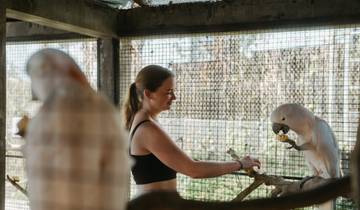
- Volunteering
- Christmas & New Year
Wildlife Volunteer in Bali
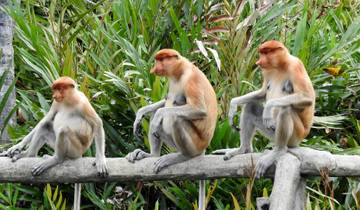
Borneo – East Sabah Adventure
This was a wonderful adventure. Seeing the wildlife - elephants, orang-utans, crocodiles turtle hatclings, proboscis monkeys etc was amazing. Experiencing local village life was very special. Loved all of it.

Sabah Adventure
Felix was amazing. Only request was to stay on river longer. It was only one night. Also I hope Borneo works on theirs carbon emissions. I felt like riding on the river I was contributing to carbon emissions from the boats. Also Turtle Island I felt again the boats could hit a turtle. My carbon foot print was very high on this trip. Mountain is not a hike but a climb. Take the brochure seriously and be in shape. Our group was but still took a lot out of us. Be prepared for no hot water or electricity through out the trip.

- Hiking & Trekking
Vietnam Classic Sightseeing Tour - 12 Days
Wonderful land in Asia ! Good operation, professional guide with skilled driver. We have unforgetable experiences in Vietnam, Vietnam is not as you though before planed your trip in your mind. Must Go and see ! Thanks all
- Book With Flexibility This operator allows you to rebook your dates or tours with them for free, waiving change fees.

Komodo Island Hopper
Spicy was an awesome guide, from getting in touch and helping prior to the trip starting to keeping us all on the schedule throughout. We were touring during monsoon season and he was amazing at keeping the spirits high even when it was raining. He has great local knowledge and really took care of the group

Highlights of Sabah & Mt Kinabalu
The itinerary did exactly as expected, showcased the highlights of Sabah. The additional activities exceeded expectations; tubing in Tambatuon village was fun for the range of ages amongst out group, on the night jungle walk in kinabatangan, we had the pleasure of strolling across an endangered tarsier. Our well-connected guide (Jerry) was actively involved in all activities and shared a wealth of knowledge, as a local. The connections Jerry has with the communities made us feel at home in Borneo. His professionalism and experience in mountain climbing made the Mt Kinabalu hike a personal highlight for me. A well-passed, humbling and spectacular adventure well worth taking.

- Mountain Hikes
Real Borneo
This trip was so much fun! It was really well coordinated with the right amount of free time. The first hotel in kota kinabalu is extremely nice but there are heaps of other cheaper hotels quite close if you're staying an extra day. If you want to see the city, stay an extra day or two as you don't get much time included in the tour. 1-2 days in KK would be enough as it's pretty small. Sepilok is really cool and there are heaps of things to do, however a lot of them are guided tours and they cost quite a bit. If you're trying to save, you could just opt to stay at the hotel as it has a pool and a restaurant. Wifi is only in the restaurant area and rooms have fans, no air con. Next is the eco camp which is really cool as it's right in the middle of the jungle. There are SO many mosquitos so don't think you can get away without repellant. Bring snacks as there's no where to get food outside of meal times. You'll probably also want lots of loose, long clothes to avoid sunburn. The tree planting you do here was pretty average but I guess cool to see. At lunch we got to do a cooking class which was pretty cool. The Batu Tulug caves were nice and worth a visit. The homestay depends a lot on your family but it's great to see how locals live. There's no wifi here or on the river at the eco camp, so if you need to check more than once every couple of days, get a local sim (they're pretty cheap anyway). Next you stay in the Kinabalu national park, which was bloody great for us because we got upgraded to this really fancy room. Once again there's no wifi and you have to buy something at a really expensive restaurant to use it. Food is all buffet here which is really fun. The hike was awesome and you can read reviews on it elsewhere, but some things specific to geckos might put some people off this tour. Firstly, we had some people on our group who had chronic medical conditions such as asthma. They were only told the day before the climb that they wouldn't be covered by insurance and if they wanted to climb it would be at their own risk. If you have something like this, it would be worth getting more comprehensive insurance and clarifying what this means for you with geckos before you go, as only learning about this the day before doesn't allow much time for decision making. Secondly, our group leader decided that we wouldn't go all the way to the summit as the weather was really bad. This was fine as we still got to base camp and got to do another smaller walk, and it's totally understandable of our group leader to put our safety first. However, a lot of other people went to the summit regardless (ie people not on our tour) and so if you're really really keen to get to the top, there's a risk you won't be able to with this tour. The poring hot springs were awesome as there are heaps of things to do there, but mostly the beds are comfortable which you'll need after the hike! The small waterfall (you'll find out when you get there) is awesome and definitely worth the 15 minute walk. The hot springs themselves are sort of gross, especially at the end of the day, as they get sort of dirty and you can see hair in them! So it's worth getting a private spa. There's also no wifi here but local cafes (ie across the road from the resort) have it. It's best to eat there too as the restaurant at the resort is really expensive. On the last day we didn't get back to KK until about 5pm and our guide organised a snorkelling trip for those of us who were still there for the next day which was really really good. Our tour guide, Felix, was absolutely awesome and was so passionate about Sabah and wildlife. This tour is a really comprehensive tour of Sabah and you get to see so much. It may seem expensive per day but we had a lot of transfers (including a flight) and got to climb Mt Kinabalu, and some of the hotels were a lot nicer than expected. One thing to keep in mind is that Malaysia is a Muslim country and for us they were celebrating ramadan at the time. This meant that a few restaurants were closed but we always found somewhere to go. We also got to experience the ramadan bazaars which were really cool! However it would have been marginally easier to go at a different time of year. This is also a great introduction into hiking and wildlife types of holidays if you haven't done that before. Sabah is a great place to travel and this tour makes it really easy and shows you the best bits.
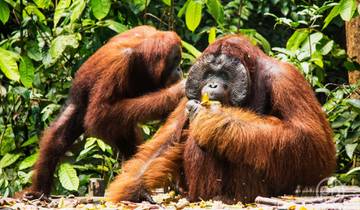
3D2N Orangutan in Tanjung Puting with Overnight on the Boat
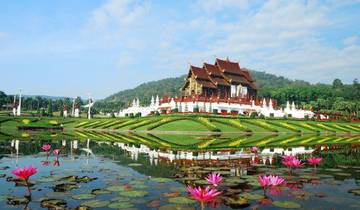
- In-depth Cultural
Trails and Gems of Siam, Small Group Tour
I had before tours, tour guide always took about history in every single stop. Ran just give us a little introduction to the historic area. an then said. Here we are, enjoy. I complain about all ready . He charge $2000 baht in Elephant Conservation visit just 2 hours . The hotel Agency In Chan Mai charge $1700 for half day . IS NOT ACCEPTABLE. This is creating bad reputation for the tour company. Then in Sukhothai Historical Park, I did not take the tour with him because I know he was chargin extra money . I purchase my own entrance and train ride for just $160 baht he charge $500 entrance and bike. I want mention about the Hotel in Kanjanburi. is TERRIBLE DIRTY AND THE FOOD ALSO. I do not like that town .I suggest take out of your tour is nothing there.
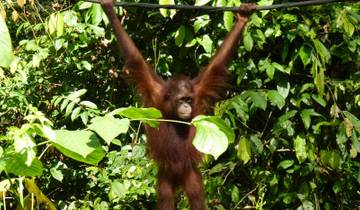
Sandakan Orangutan Experience 4D/3N
Great wildlife to see, friendly staff in the lodges, plentiful food, rustic but nice accommodation, knowledgeable guides but a little expensive for what's included as there's a lot of free time.
- 10% deposit on some dates Some departure dates offer you the chance to book this tour with a lower deposit.

A Week In Palawan, Philippines
One Week in Palawan comprises three cities: Puerto Princesa, El Nido and Coron, in that order. Hopping from one city to another means joining different sets of tourists for that occasion only. Be ready to mingle, particularly the long road trip of 5 hours from Puerto Princesa to El Nido in a medium-sized van. This is not a private tour; you are at once mingled with whomever at the discretion of your tour operator. And be ready to spend because vendors of all shades pop out of nowhere offering useful and not-so-useful items. Tips to your guides/helpers are encouraged as they serve you as best they could to a fault, as they are integral to a decent means of livelihood. The Palawan tour is well-organized, the accommodations superb, the experience memorable. Value-for-money package tour, airfare, shipfare (El Nido to Coron) included. Two-thumbs up!!

- Jungle Trekking
Best of Borneo National Geographic Journeys
Great tour, well organized.

Best of Bali & Komodo Escape
Incredible adventure!! I personalised this tour to skip Bali and went to Ubud and Komodo. The hotels used were fantastic and very well located, with the views in Komodo out of this world. The driver guides for the day trips in Ubud friendly and knowledgeable and we saw so many cool places, they even took us to extra sights we wanted to see. The boat trip to Komodo was the highlight with the most stunning beaches I've ever seen, and of course the huge Komodo dragons. Communication from Vio Travel was excellent from start to finish, as well as there local contact via WhatsApp when in Indonesia, there was always someone to ask any questions or assist. I highly recommend this trip and Vio Travel, thank you!!
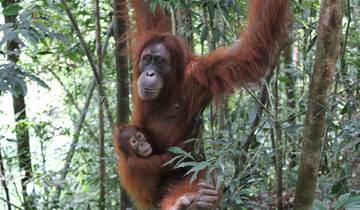
Borneo Wildlife Discoverer
Borneo was a fabulous trip. Our guide, Nostalia, was knowledgeable, organized, funny, intuitive about our (wonderful) group and made every day and every excursion interesting and fun. I was very pleased by all the flora and fauna we saw, the hikes we took and the lodges we stayed in. Thank you!!!
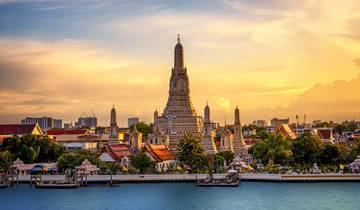
Best of Northern Thailand
Trip was fast paced with some varied experiences. More accurate dress information prior to attending temples would have been useful but pre holiday research could have found that out anyway. Another day in chiang mai would have been 4 as elephant trip was practically a full day and the optional tours limited opportunity to explore. Great trip... Although I am templed out now!
What people love about Wildlife Tours in South East Asia
If you are looking for a nature holiday, I would most defiantely recommend Borneo. Saw all the wildlife I had hoped for and more. Our CEO with G Adventures, Ricky, was fantastic. Helpful, kind, knowledgable and very calm. Always happy to help and answer any questions regarding the wildlife or history of Borneo. The group was also fantastic, full of laid back, like minded, wildlife lovers, from all over the world. Thank you!!
This trip was amazing and exceeded my expectations. I loved the mix of culture, nature, hiking and relaxing.
Travel Styles
- 10 Amazing Wildlife Tours & Trips 2024/2025

Animals Around The Globe (US)
Animals and Wildlife in Thailand
Posted: April 26, 2024 | Last updated: April 26, 2024
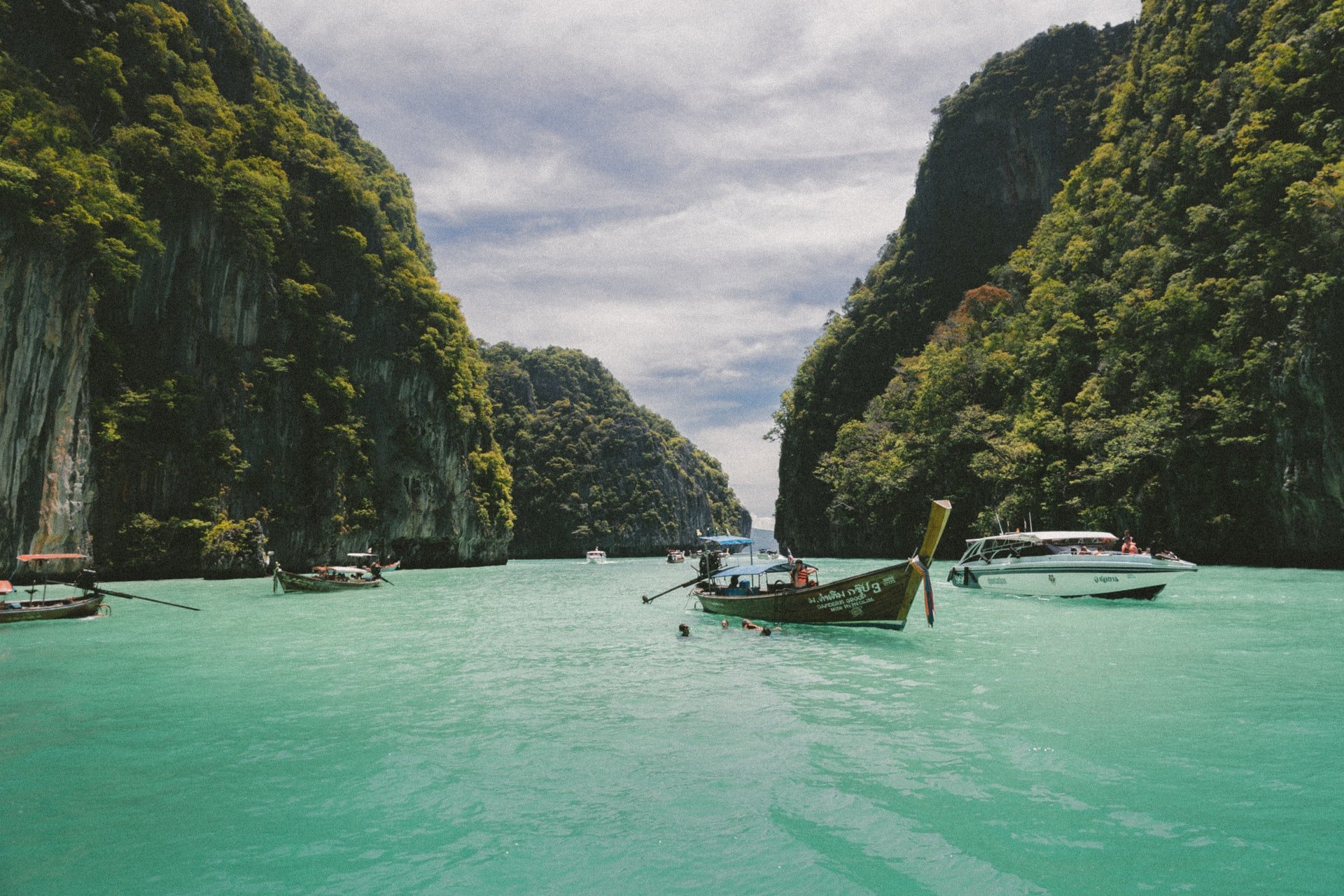
Welcome to Animals and Wildlife in Thailand.
Thailand is a popular and stunning beach destination in Southeast Asia. This country, rich in culture and beauty, also is home to incredible animals and wildlife. We will pinpoint and discover but a few of these fantastic animals . Thailand hosts over 10% of global animal species, including 285 mammals like elephants, tigers, leopards, sun bears, deer, otters, and various primates. The island also features sheep, goats, wild cattle, and hogs. Explore the blog using these headings or read it all.
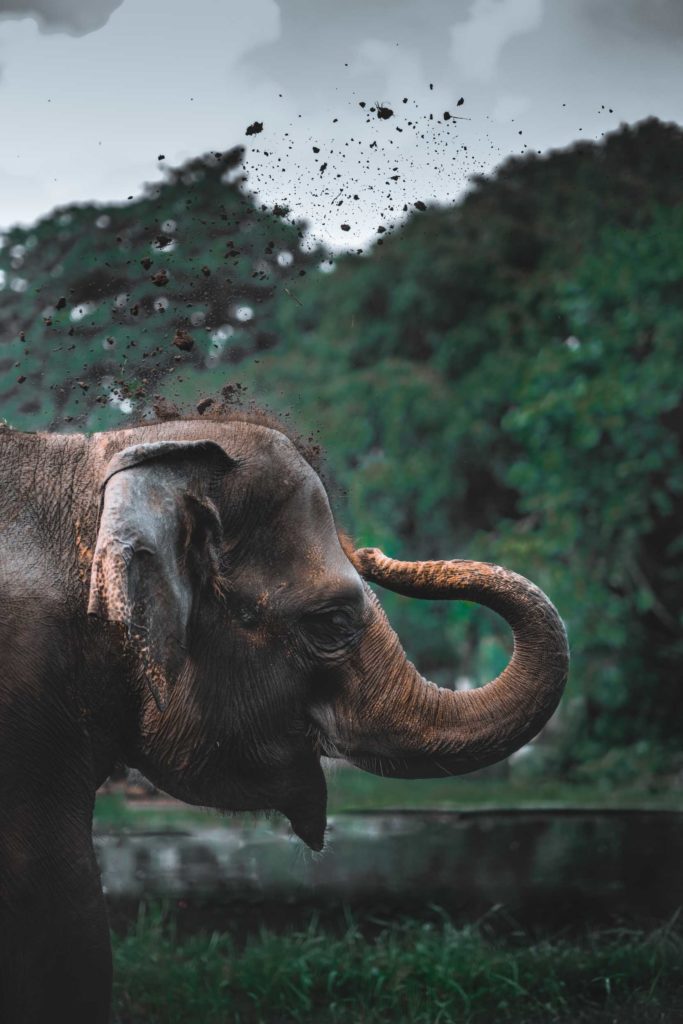
Animals and Wildlife in Thailand: Elephants
The Roles of Elephants in the Past
Thailand is home to Indian elephants, a subspecies of the Asian elephant. Once, the country teemed with wild elephants, boasting an estimated population of approximately 100,000 in 1900, as reported by the Food and Agriculture Organization (FAO) of the United Nations. However, today, the elephant landscape has drastically changed, with only between 3,000 and 4,000 elephants remaining in Thailand. Tragically, nearly half of them endure captivity and challenging living conditions. This decline in numbers has led to the classification of Asian elephants as endangered by the International Union for the Conservation of Nature (IUCN).
There are approximately 2000 wild elephants in Thailand. After a 1989 logging ban, most logging elephants ended up in the tourist industry. This is a massive tourist trap, and the elephants caught in this sickening trade are severely abused and mistreated. Many of Thailand’s captive elephants are poached from the wild, leading to 60% of Thailand’s total elephant population being captive elephants, and 60% of those are used for tourism. Elephants are so ingrained in Thai culture that they are recognized as a symbol of national identity. For hundreds of years, these incredible creatures have stood alongside Thai people in pursuits such as war, labor, transportation, and, more recently and unfortunately, tourism.
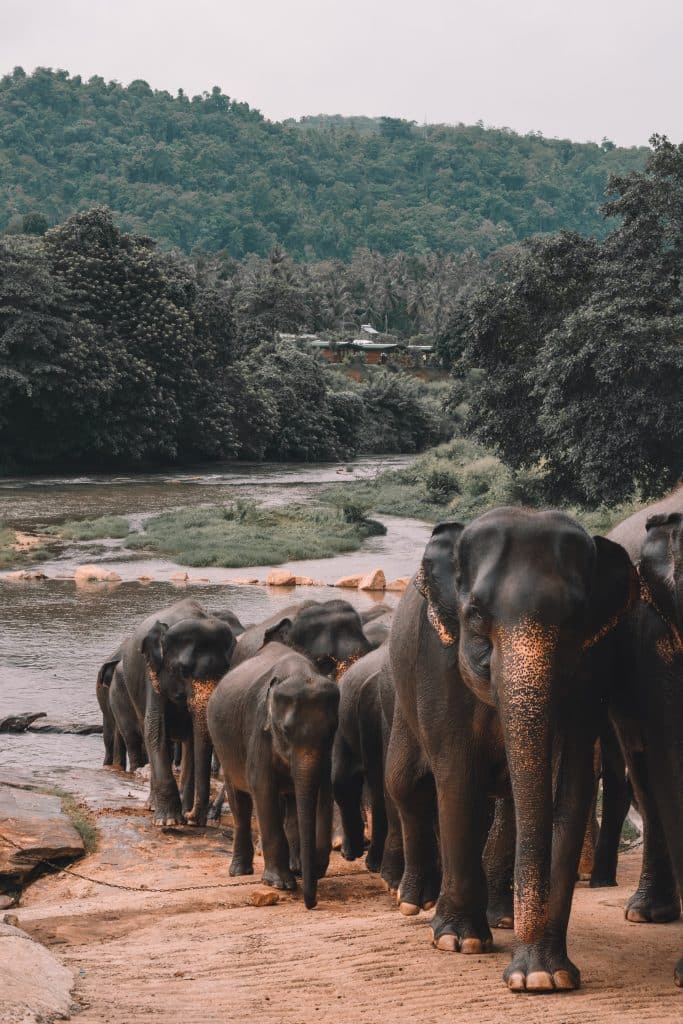
Image by alex azabache via Unsplash
Elephants and War

Image by marc bombenon via Unsplash
Elephant sanctuaries are becoming more popular, offering tourists the chance to feed or bathe elephants, instead of riding them. However, these sanctuaries still involve unnatural behaviour and a high level of interaction between people and elephants. GVI's Chiang Mai elephant project is pioneering a new approach to elephant tourism. Our project limits interaction to the minimum required, while still supporting the elephants and their mahouts, and giving volunteers an incredible once-in-a-lifetime experience.
Elephants and Labour In addition to being used in battles, elephants were also put to work in the logging industry, hauling teak wood through dense jungle. Ironically, elephants were used to destroy their own habitat. Logging was banned in Thailand in 1989, but by then the damage had been done. In 1900, Thailand had around 90% forest cover. By 1989, only 28% of the country's forests remained, according to FAO. This habitat loss and the fragmented nature of the remaining forests are among the biggest threats to the survival of the Asian elephant. The banning of logging and the rise of modern transportation left many traditional elephant keepers, known as mahouts, and their elephants without the income required for their care. As a result, many turned to the tourism trade for income. Elephant tourism proved to be hugely popular, and despite ongoing concerns around the welfare of the animals, is still on the rise. A two-year study published in 2017 by World Animal Protection found that since 2010, there has been a 30% increase in the number of elephants living in captivity at tourism venues in Thailand. Riding elephants in Thailand Riding elephants in Thailand is unethical. The systematic abuse of captive elephants in order to "train" them to carry tourists is common. Plus, the elephants have to endure long working days, limited food, and unnatural environments, such as hours spent standing on concrete. More and more tourists wishing to travel in an ethical and sustainable way are shunning the practice. However, boycotting elephant tourism altogether might not be the answer. The situation is complex and requires solutions that take into account the well-being of both the elephants and their mahouts. Today, tourism is the only viable source of income for mahouts and their elephants. Elephants need to eat around 250 kilograms of food per day, which can cost their owners around $1,000 a month. The tourism industry helps to raise the funds needed to care for the gigantic animals and provide a livelihood for mahouts and their families.It's clear that the tourism model needs to change, but it also needs to exist in some form to ensure the elephants currently living in captivity are taken care of.
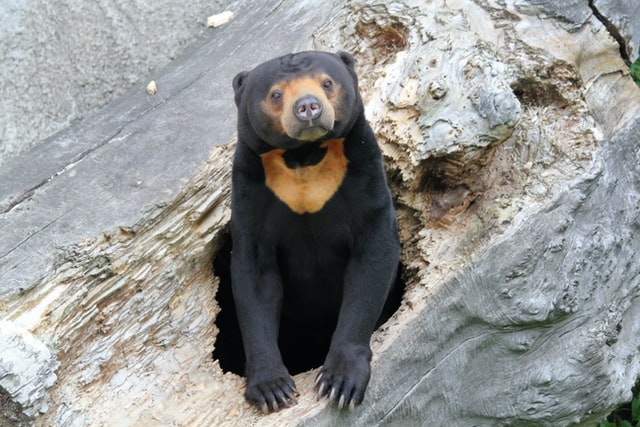
Wildlife in Thailand: Malaysian Sun Bear
The Sun Bear was formerly widespread in the lowland forests of South East Asia. However, it has mostly disappeared from most of its former range in recent decades. Nevertheless, Sun Bear is still widespread in a few protected areas in Camboda ‘s Mondolkiri province and Virachey National Park. It is thought that the population fell by more than 30% in the last 30 years. Can you think of any reasons for this?
The Malaysian sun bear can be clearly distinguished from other bears by a white or yellowish patch on the chest. They form a small part of Wildlife in Thailand but are certainly special as they are rare and unique. Sun bears are excellent climbers and spend considerable amounts of time in trees. They feed on sweet fruits, small rodents, birds, termites, and insects. They can be considered relatively small as they are merely 120-150clongth and can weigh only 35-80 kg.

Image by Darren welsh via Unsplash
These are only a fetragedies facingce Wildlife in Thailand today.
There are several threats to these gorgeous Malaysian Sun Bears… Like other bears in Asia, Sun bears are hunted for their gallbladders and other body parts for medicinal uses thascientist have proven to have no medical value at all. This can hopefully change in years to come with more education to individuals about the lack of medicinal properties this poor innocent animal contains. Female nursing sun bears are sometimes killed, and their cubs are captured to be sold in the pet trade. This a significant issue not exclusive to Wildlife in Thailand but, sadly, globally. And Habitat destruction caused by clearance for plantation development and illegal logging is another major threat to this species’s small remaining critical population.
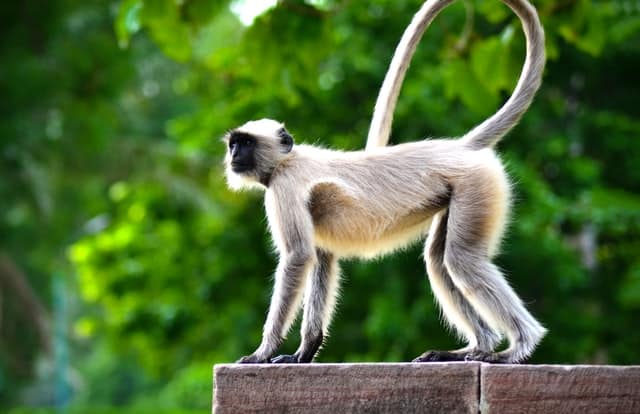
Wildlife in Thailand: Gibbons
Gibbon (family Hylobatidae) is any of approximately 20 species of small apes found in the tropical forests of Southeast Asia. Gibbons, like the great apes (gorillas, orangutans, chimpanzees, and bonobos), have a humanlike build and no tail (like for balance). Still, gibbons seem to lack higher cognitive abilities and self-awareness. They also differ from great apes in having considerably longer arms, dense hair, and a throat sac for amplifying sounds. Gibbon’s voices are loude musical in tone, and carry over long distances. The most characteristic vocalization is the "great call," usually a duet in which the female leads and the male joins in with less-complex notes, used as a territorial marker by both sexes.
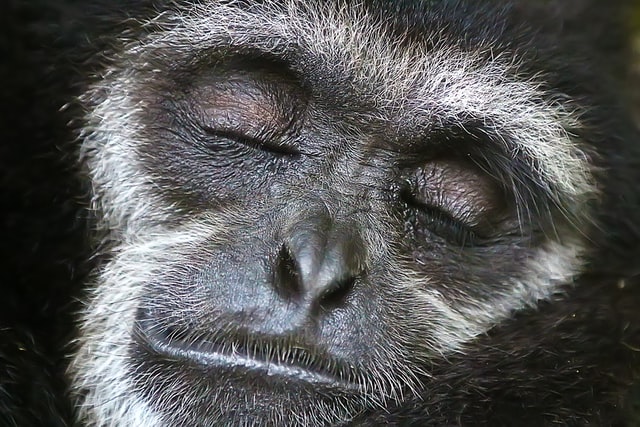
Image via Unsplash
Gibbons are arboreal and move from branch to branch with speed and great agility by swinging from their arms (brachiating). On the ground, gibbons walk erect with their arms held aloft or behind. They are active during the day and live in small monogamous groups that defend territories in the treetops. They feed mainly on fruit, with varying proportions of leaves and with some insects, bird eggs, and young birds. Single offspring are born after about seven months' gestation and take seven years to mature. Most gibbon species are about 40–65 cm (16–26 inches) in head and body length. The smaller species (both sexes) weigh about 5.5 kg (12 pounds); others, such as the concolor gibbon, weigh about 7.5 kg (17 pounds). The female siamang weighs 10.5 kg (23 pounds) and the male 12 kg (26 pounds); the siamang is the only gibbon with a significant size difference between the sexes.
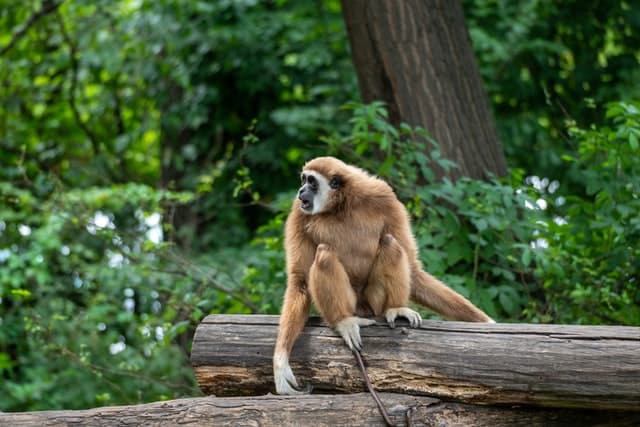
Image by jozsef hocza via Unsplash
The post Animals and Wildlife in Thailand appeared first on Animals Around The Globe .
If you enjoyed this blog, you might like other blogs from Animals Around the Globe! Like Top 10 Pet Animals in India or Wildlife in Asia .
What have you found interesting about the wildlife of Thailand? Is Thailand somewhere you’re interested in traveling to soon?
Animals in Thailand: Indochinese leopard
In Thailand, the Indochinese leopard is present in the Western Forest Complex, Kaeng Krachan-Kui Bu,ri and Khlong Saeng-Khao Sok protected area complexes. But since the turn of the 21st century, it has not been recorded anymore in the country’s northern and south-central forest complexes. The leopard’s remarkable success in the wild can be attributed to a combination of key traits and abilities. Its well-camouflaged fur allows it to blend seamlessly into its surroundings, making it a stealthy predator. It’s an opportunistic hunter with a diverse diet, capable of taking down a wide range of prey. Its strength enables it to hoist heavy carcasses into trees to keep them safe from scavengers.
This adaptable big cat can thrive in a variety of habitats, from lush rainforests to open steppe lands, arid deserts, and even rugged mountain areas. In addition to its agility, it possesses remarkable speed, allowing it to sprint at impressive rates.
Leopards exhibit a striking range of coat colors and rosette patterns. Their coat can span from pale yellow to deep gold or tawny, adorned with black rosettes. The head, lower limbs, and belly are adorned with solid black spots. These coat colors and patterns are closely linked to their specific habitats. In East Africa, their rosettes tend to be circular, whereas in southern Africa, they appear more square, and in Asian populations, they tend to be larger.
Their adaptability is further showcased in their coat variations across different environments. In desert regions, their fur tends to be lighter, almost cream-colored. In colder climates, their coats take on a grayer hue, while in lush rainforests, they adopt a richer, darker golden tone.
Their underbelly fur is both softer and lighter in color compared to the rest of their coat. Instead of open rosettes, you’ll find solid black spots on their face, limbs, and underbelly, adding to the intriguing mosaic of their appearance.
Leopards are versatile, opportunistic hunters and have a comprehensive diet. They feed on a greater diversity of prey than other members of the Panthera genus and are reported to eat anything from dung beetles to common elands. However, medium-sized prey species in the 20-80 kg range are usually taken. The largest prey written killed by a leopard was a 900 kg male eland. Although leopards generally do not prey on such large animals.
Their diet consists mainly of ungulates, followed by primates, primarily monkeys of various species, including the Vervet monkey. However, they will also opportunistically eat rodents, reptiles, amphibians, insects, birds (especially ground-based types like the vulturine guineafowl), fish, and sometimes smaller predators (such as foxes, jackals, martens, and smaller felid species).
Summary of Animals and Wildlife in Thailand
Gibbons are still widely distributed iSoutheast Asia’she rainforests and monsoon foresia, but they are more and more under threat as their forest habitat is destroyed. They are sometimes hunted for food, but they are often, killed for their supposed medicinal properties; their long arm bones are especially prized.
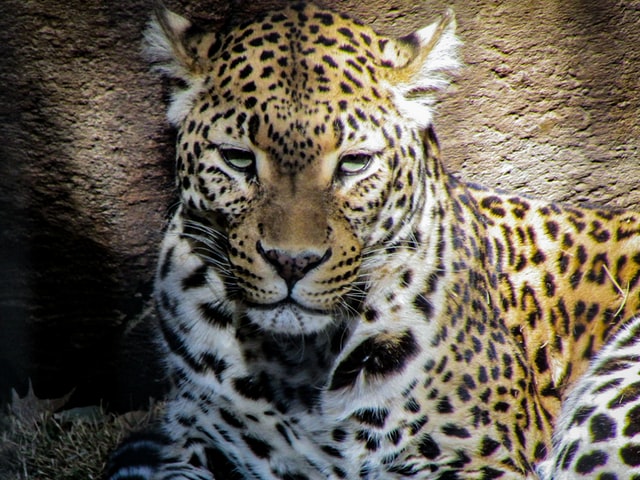
Image via Himesh Kumar Behera thehopefultraveller, CC0, via Wikimedia Commons
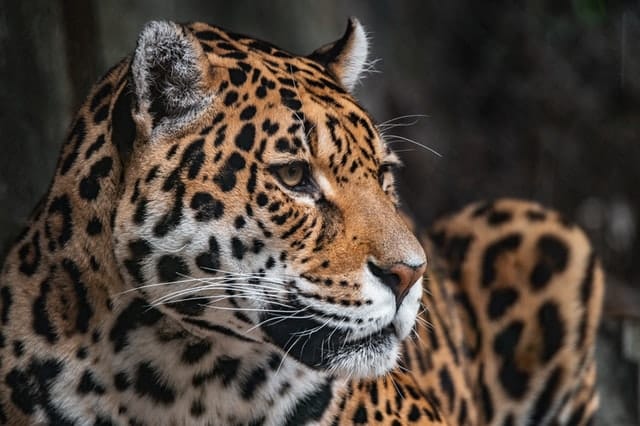
Image by Mike van den bos via Unsplash
More for you.
29 common human foods you may not realize are poisonous to your dog
Do I have to pay off my spouse's debts when they die? Here's what you're responsible for and what you aren't after a loved one's death
Here is how much you must gross in pay per state to take home $100K
Major Steakhouse Chain Closes 41 Locations
A woman said her tattoos got her rejected for a job, but experts say personality is far more important
Eagles' A.J. Brown just made signing CeeDee Lamb even harder for the Cowboys
223 vs 556: What's the Difference?
Scientists claim people with this blood type more likely to have early stroke
5 Things the Average Retiree Won’t Be Able to Afford in the Next 5 Years
One of these pictures of me is real and the other is AI – but which is which?
The lowest-earning college major in America, according to data—and the see runners-up
11 Facts You Should Know About Hard-Boiled Eggs
iPhone users in 92 countries received a recent stark warning
Baking Soda Makes a Great DIY Weed Killer—Here's How to Use It
Watch: Russell Westbrook Throws Punch After Hard Foul On Luka Doncic
I’m a Bank Teller: 3 Times You Should Never Ask For $100 Bills at the Bank
Map reveals best places to live in the US if nuclear war breaks out
The Best Time To Take Vitamin D To Maximize The Mental And Physical Benefits, According To Experts
12 Secret Ingredients Grandma Used in Her Meatloaf
Ghosts of the USA: The Most Haunted Places in America
- Bahasa Indonesia
- Slovenščina
- Science & Tech
- Russian Kitchen
Moscow metro to be more tourist-friendly

A new floor sign system at the Moscow metro's Pushkinskaya station. Source: Vladimir Pesnya / RIA Novosti
For many years now, Moscow has lagged behind St. Petersburg when it comes to making life easy for tourists, especially where getting around the city is concerned. Whereas the northern capital installed English-language maps, signs and information points throughout its subway system in the late 2000s, the Russian capital’s metro remained a serious challenge for foreign visitors to navigate.
Recent visitors to Moscow may have noticed some signs that change is afoot, however. In many stations of the Moscow subway, signs have appeared on the floor – with large lettering in Russian and English – indicating the direction to follow in order to change lines. Previously, foreign visitors using the Moscow metro had to rely solely upon deciphering the Russian-language signs hanging from the ceilings.
Student volunteers help tourists find their way in Moscow
However, this new solution has a significant drawback. “The floor navigation is visible only to a small stream of people – fewer than three people per meter. During peak hours, this navigation will simply not be noticed,” said Konstantin Trofimenko, Director of the Center for Urban Transportation Studies.
One of the biggest problems for tourists in the Russian capital remains the absence of English translations of the names of subway stations in the station vestibules and on platforms. The Department of Transportation in Moscow has not commented yet as to when this problem will be solved. However, Latin transliterations of station names can already be found in the subway cars themselves.
Finding the right exit
At four of the central stations – Okhotny Ryad, Teatralnaya, Ploshchad Revolyutsii, Lubyanka and Kuznetsky Most – the city authorities have now installed colorful stands at the exits with schematic diagrams of the station’s concourse and surrounding area, which provide information about the main attractions and infrastructural facilities.
The schematic diagrams are the work of British specialists from the City ID and Billings Jackson Design firms, who have already implemented successful projects in New York and London.
According to Alexei Novichkov, expert at the Design Laboratory at the Higher School of Economics, the design of these information booths raises no objections: The color solutions, font, layout and icons are consistent with international standards.

However, the stands do have some shortcomings. “Many questions are raised about the fact that the developers of these maps did not apply orientation to the north, and have provided layouts of the surrounding areas with respect to the exits,” says Novichkov. “A system like that is used for road navigators, but most of the ‘paper’ guides and maps are oriented strictly to north. The subway map is also oriented to north, so people may become confused.”
Muscovites and foreign visitors are generally positive about these navigation elements, with most of them citing the numbered exits from the subway as the most useful feature.
The fact is that many Moscow subway stations have several exits. One of the busiest central stations of the Moscow subway in particular, Kitay-Gorod, has more than a dozen exits. Previously, these exits were differentiated from each other only with signs in Russian referring to the names of streets and places of interest to which they led – making it easy for tourists and those with poor navigation skills to get confused.
Now, when making an appointment to meet a friend, instead of struggling to find the right spot when they tell you: “I'll meet you at the exit to Solyanka Street,” you can just propose to meet under a specific exit number.
“I’ve lived in Moscow for seven years,” says Angelika, a designer from Voronezh, “but I still don’t always know where to go to find the place I need, so the new schematic diagrams will be very useful. Previously, some subway stations had maps, but not with so much detail.”
Teething problems
Foreigners, meanwhile, focus their attention on other elements. “It is good that the new information boards have QR-codes, which can be ‘read’ by smartphones,” says Florentina, a writer from Vienna. But there are also shortcomings. “The English font of the information on posters and in the captions to theaters and museums is too small – you have to come very close to see it well,” she says.
Pleasant encounters on the streets of Moscow
Florentina was also dissatisfied with the fact that such posters are not provided at all subway stations: “When I was trying to find Tsaritsyno Park (a museum and reserve in the south of Moscow) at a subway station with the same name, it turned out to be quite difficult,” she says.
“There are no maps with landmarks for other areas, such as those already in the city center. There were no clear pointers in the English language, and the passers-by I met did not speak in English, so they could not help me,” she adds.
Officials say that the navigation system is gradually being redeveloped and improved. According to Darya Chuvasheva, a press representative for the Department of Transport of Moscow, the introduction of a unified navigation system will take place in stages.
“By the end of 2014, the system will first appear on the first subway stations on the Circle Line. By the end of 2015, we plan to install the system at all major stopping points, subway stations and transport interchange hubs,” says Chuvasheva.
All rights reserved by Rossiyskaya Gazeta.
to our newsletter!
Get the week's best stories straight to your inbox
This website uses cookies. Click here to find out more.

Turn Your Curiosity Into Discovery
Latest facts.
9 Facts About National Train Day May 11th
12 Facts About National Coq Au Vin Day May 29th
40 facts about elektrostal.
Written by Lanette Mayes
Modified & Updated: 02 Mar 2024
Reviewed by Jessica Corbett

Elektrostal is a vibrant city located in the Moscow Oblast region of Russia. With a rich history, stunning architecture, and a thriving community, Elektrostal is a city that has much to offer. Whether you are a history buff, nature enthusiast, or simply curious about different cultures, Elektrostal is sure to captivate you.
This article will provide you with 40 fascinating facts about Elektrostal, giving you a better understanding of why this city is worth exploring. From its origins as an industrial hub to its modern-day charm, we will delve into the various aspects that make Elektrostal a unique and must-visit destination.
So, join us as we uncover the hidden treasures of Elektrostal and discover what makes this city a true gem in the heart of Russia.
Key Takeaways:
- Elektrostal, known as the “Motor City of Russia,” is a vibrant and growing city with a rich industrial history, offering diverse cultural experiences and a strong commitment to environmental sustainability.
- With its convenient location near Moscow, Elektrostal provides a picturesque landscape, vibrant nightlife, and a range of recreational activities, making it an ideal destination for residents and visitors alike.
Known as the “Motor City of Russia.”
Elektrostal, a city located in the Moscow Oblast region of Russia, earned the nickname “Motor City” due to its significant involvement in the automotive industry.
Home to the Elektrostal Metallurgical Plant.
Elektrostal is renowned for its metallurgical plant, which has been producing high-quality steel and alloys since its establishment in 1916.
Boasts a rich industrial heritage.
Elektrostal has a long history of industrial development, contributing to the growth and progress of the region.
Founded in 1916.
The city of Elektrostal was founded in 1916 as a result of the construction of the Elektrostal Metallurgical Plant.
Located approximately 50 kilometers east of Moscow.
Elektrostal is situated in close proximity to the Russian capital, making it easily accessible for both residents and visitors.
Known for its vibrant cultural scene.
Elektrostal is home to several cultural institutions, including museums, theaters, and art galleries that showcase the city’s rich artistic heritage.
A popular destination for nature lovers.
Surrounded by picturesque landscapes and forests, Elektrostal offers ample opportunities for outdoor activities such as hiking, camping, and birdwatching.
Hosts the annual Elektrostal City Day celebrations.
Every year, Elektrostal organizes festive events and activities to celebrate its founding, bringing together residents and visitors in a spirit of unity and joy.
Has a population of approximately 160,000 people.
Elektrostal is home to a diverse and vibrant community of around 160,000 residents, contributing to its dynamic atmosphere.
Boasts excellent education facilities.
The city is known for its well-established educational institutions, providing quality education to students of all ages.
A center for scientific research and innovation.
Elektrostal serves as an important hub for scientific research, particularly in the fields of metallurgy, materials science, and engineering.
Surrounded by picturesque lakes.
The city is blessed with numerous beautiful lakes, offering scenic views and recreational opportunities for locals and visitors alike.
Well-connected transportation system.
Elektrostal benefits from an efficient transportation network, including highways, railways, and public transportation options, ensuring convenient travel within and beyond the city.
Famous for its traditional Russian cuisine.
Food enthusiasts can indulge in authentic Russian dishes at numerous restaurants and cafes scattered throughout Elektrostal.
Home to notable architectural landmarks.
Elektrostal boasts impressive architecture, including the Church of the Transfiguration of the Lord and the Elektrostal Palace of Culture.
Offers a wide range of recreational facilities.
Residents and visitors can enjoy various recreational activities, such as sports complexes, swimming pools, and fitness centers, enhancing the overall quality of life.
Provides a high standard of healthcare.
Elektrostal is equipped with modern medical facilities, ensuring residents have access to quality healthcare services.
Home to the Elektrostal History Museum.
The Elektrostal History Museum showcases the city’s fascinating past through exhibitions and displays.
A hub for sports enthusiasts.
Elektrostal is passionate about sports, with numerous stadiums, arenas, and sports clubs offering opportunities for athletes and spectators.
Celebrates diverse cultural festivals.
Throughout the year, Elektrostal hosts a variety of cultural festivals, celebrating different ethnicities, traditions, and art forms.
Electric power played a significant role in its early development.
Elektrostal owes its name and initial growth to the establishment of electric power stations and the utilization of electricity in the industrial sector.
Boasts a thriving economy.
The city’s strong industrial base, coupled with its strategic location near Moscow, has contributed to Elektrostal’s prosperous economic status.
Houses the Elektrostal Drama Theater.
The Elektrostal Drama Theater is a cultural centerpiece, attracting theater enthusiasts from far and wide.
Popular destination for winter sports.
Elektrostal’s proximity to ski resorts and winter sport facilities makes it a favorite destination for skiing, snowboarding, and other winter activities.
Promotes environmental sustainability.
Elektrostal prioritizes environmental protection and sustainability, implementing initiatives to reduce pollution and preserve natural resources.
Home to renowned educational institutions.
Elektrostal is known for its prestigious schools and universities, offering a wide range of academic programs to students.
Committed to cultural preservation.
The city values its cultural heritage and takes active steps to preserve and promote traditional customs, crafts, and arts.
Hosts an annual International Film Festival.
The Elektrostal International Film Festival attracts filmmakers and cinema enthusiasts from around the world, showcasing a diverse range of films.
Encourages entrepreneurship and innovation.
Elektrostal supports aspiring entrepreneurs and fosters a culture of innovation, providing opportunities for startups and business development.
Offers a range of housing options.
Elektrostal provides diverse housing options, including apartments, houses, and residential complexes, catering to different lifestyles and budgets.
Home to notable sports teams.
Elektrostal is proud of its sports legacy, with several successful sports teams competing at regional and national levels.
Boasts a vibrant nightlife scene.
Residents and visitors can enjoy a lively nightlife in Elektrostal, with numerous bars, clubs, and entertainment venues.
Promotes cultural exchange and international relations.
Elektrostal actively engages in international partnerships, cultural exchanges, and diplomatic collaborations to foster global connections.
Surrounded by beautiful nature reserves.
Nearby nature reserves, such as the Barybino Forest and Luchinskoye Lake, offer opportunities for nature enthusiasts to explore and appreciate the region’s biodiversity.
Commemorates historical events.
The city pays tribute to significant historical events through memorials, monuments, and exhibitions, ensuring the preservation of collective memory.
Promotes sports and youth development.
Elektrostal invests in sports infrastructure and programs to encourage youth participation, health, and physical fitness.
Hosts annual cultural and artistic festivals.
Throughout the year, Elektrostal celebrates its cultural diversity through festivals dedicated to music, dance, art, and theater.
Provides a picturesque landscape for photography enthusiasts.
The city’s scenic beauty, architectural landmarks, and natural surroundings make it a paradise for photographers.
Connects to Moscow via a direct train line.
The convenient train connection between Elektrostal and Moscow makes commuting between the two cities effortless.
A city with a bright future.
Elektrostal continues to grow and develop, aiming to become a model city in terms of infrastructure, sustainability, and quality of life for its residents.
In conclusion, Elektrostal is a fascinating city with a rich history and a vibrant present. From its origins as a center of steel production to its modern-day status as a hub for education and industry, Elektrostal has plenty to offer both residents and visitors. With its beautiful parks, cultural attractions, and proximity to Moscow, there is no shortage of things to see and do in this dynamic city. Whether you’re interested in exploring its historical landmarks, enjoying outdoor activities, or immersing yourself in the local culture, Elektrostal has something for everyone. So, next time you find yourself in the Moscow region, don’t miss the opportunity to discover the hidden gems of Elektrostal.
Q: What is the population of Elektrostal?
A: As of the latest data, the population of Elektrostal is approximately XXXX.
Q: How far is Elektrostal from Moscow?
A: Elektrostal is located approximately XX kilometers away from Moscow.
Q: Are there any famous landmarks in Elektrostal?
A: Yes, Elektrostal is home to several notable landmarks, including XXXX and XXXX.
Q: What industries are prominent in Elektrostal?
A: Elektrostal is known for its steel production industry and is also a center for engineering and manufacturing.
Q: Are there any universities or educational institutions in Elektrostal?
A: Yes, Elektrostal is home to XXXX University and several other educational institutions.
Q: What are some popular outdoor activities in Elektrostal?
A: Elektrostal offers several outdoor activities, such as hiking, cycling, and picnicking in its beautiful parks.
Q: Is Elektrostal well-connected in terms of transportation?
A: Yes, Elektrostal has good transportation links, including trains and buses, making it easily accessible from nearby cities.
Q: Are there any annual events or festivals in Elektrostal?
A: Yes, Elektrostal hosts various events and festivals throughout the year, including XXXX and XXXX.
Was this page helpful?
Our commitment to delivering trustworthy and engaging content is at the heart of what we do. Each fact on our site is contributed by real users like you, bringing a wealth of diverse insights and information. To ensure the highest standards of accuracy and reliability, our dedicated editors meticulously review each submission. This process guarantees that the facts we share are not only fascinating but also credible. Trust in our commitment to quality and authenticity as you explore and learn with us.
Share this Fact:

IMAGES
VIDEO
COMMENTS
A further 5 snapshots are examined briefly to illustrate the breadth and importance of wildlife tourism across Asia and the Pacific. In order to reflect the diversity in both geographical scope and market segment of the sector, a variety of operations were selected including examples from the private sector, the accommodation and transport ...
The Global Wildlife Program (GWP) is led by the World Bank and funded by a $131 million grant from the Global Environment Facility (GEF). The program is working with 19 countries across Africa and Asia to promote wildlife conservation and sustainable development by combatting illicit trafficking in wildlife, and investing in wildlife-based tourism.
Asia and the Pacific. Wildlife tourism refers to the observation and interaction with local animal and plant life in their natural habitats. It encompasses segments such as eco-tourism, safari tours and mountain tourism among others. Wildlife watching tourism occurs mainly in protected areas. Nature, national parks and wildlife are considered ...
Table of Contents. Best Places to See Wildlife in Asia. Blue Whale Watching in Mirissa, Sri Lanka. A Jungle Safari in Karnataka, India. The Great Monkey Attack of Angkor Wat, Cambodia. Pygmy Elephants in Borneo. Tarsiers and Black Macaques in Sulawesi, Indonesia. Swimming with Turtles in Apo Island, Philippines.
Call 1.406.541.2677. Take a river cruise through different parts of Asia where you can view incredible animals such as bengal tigers, sun bears, orangutans, and elephants during a wildlife and safari exploration tour. Customize your trip to include other activities such as village visits, local market visits, snorkeling, hiking, biking ...
By Natasha Daly. May 23, 2019. • 8 min read. Right away, Elephant Valley Thailand felt different. The property, nestled in the forest on the outskirts of Chiang Rai, a small city in northern ...
UN's World Tourism Organisation last year commissioned Professor Noel Scott (who subcontracted WTA chair Dr Ronda Green as co-editor, with UNWTO's approval) to put together a report on good practice examples of sustainable wildlife tourism in Asia and the Pacific. After many months that report is now available as a free downloadable pdf. Dr Scott
4. Gir Forest National Park, India. The world-famous Asiatic lions can only be found in Gir Forest National Park, a wildlife sanctuary in the Indian state of Gujarat. In 2015, there were over 500 lions living in Gir National Park, where you may see the royal lions wandering freely in the wild.
Asia is a popular destination for wildlife tourism. From the majestic Asian elephant to the mighty Indonesian Komodo dragon, from the iconic Bornean orangutan to the regal Philippine eagle, the continent is full of breathtaking wildlife encounters that draw tourists from around the world. And yet,
Asia wildlife holidays are as varied as the landscapes and habitats available on the continent, making it one of the most beautiful places in the world to spot animals. Explore the guides below to find out more about the wildlife tourism available in Asia.
It has as major focus on wildlife conservation in Africa and Asia and the Pacific as wildlife acquires a global dimension in these parts of the world. The initiative includes approaches such as capacity building, media engagement, research and talent development and addresses multiple stakeholders like governments, tourism administrations ...
3. Kanha National Park, India. The famous masterpiece, The Jungle Book, authored by Rudyard Kipling was created after this magnificent park. The author was inspired by its evergreen thick forests, meadows, ravines, and Kanha gorges. It is touted as the most picture-perfect wildlife park in Asia.
Sabrine Ong picks out the top 5 places to see wildlife in Asia. (Text by Sabrine Ong. Photo by Shutterstock) 1. YALA NATIONAL PARK, SRI LANKA. Yala is the second largest national park in Sri Lanka, home to Panthera pardus kotiya, a native leopard. The 130,000 hectares of diverse landscape consists of forestry, grasslands and lagoons.
All Asia Nature & Wildlife Tours can be privately customized & designed to suit your personal desire. Blessed with plenty of wildlife attractions (e.g., Kalimantan Island, Sumatra Island, Sabah, Sarawak, Danjugan and Bohol), a wide variety of terrain and the stunning landscape, Asia is a truly home to the most wonderful wildlife which you won ...
Wildlife Tours in Asia. ... Thanks are due, too, to Responsible Travel for suggesting Swotah. I would highly recommend Swotah and would always be happy to communicate with any potential customers and tell them Swotah is the best Phil and Ruth Dodd, UK Destinations
This is also a great introduction into hiking and wildlife types of holidays if you haven't done that before. Sabah is a great place to travel and this tour makes it really easy and shows you the best bits. Destinations Kota Kinabalu, Kinabatangan Wildlife Sanctuary, Sepilok, Mount Kinabalu National Park, Poring +4 more Age Range 18 to 35 year olds
Tourist guides and information centres in Southeast Asia have been fuelling the illegal wildlife trade by facilitating consumption by tourists, several investigations show. Prior to Covid-19, shops trading wildlife items, from ivory bangles to tortoise shells, relied heavily on tourists, forming partnerships with travel agents and tour guides.
Asia, and illegal wildlife trade in both East Asia and the Pacific. Members have a common future priority of wildlife disease surveillance. In South Asia, capacity building was identified as key for this, while in the Pacific the focus was on zoonotic diseases. Information shared by Members during these meetings will be used as a basis for
Welcome to Animals and Wildlife in Thailand. Thailand is a popular and stunning beach destination in Southeast Asia. This country, rich in culture and beauty, also is home to incredible animals ...
Moscow metro to be more tourist-friendly. Aug 11 2014 Yelena Dolzhenko specially for RIR A new floor sign system at the Moscow metro's Pushkinskaya station. ...
40 Facts About Elektrostal. Elektrostal is a vibrant city located in the Moscow Oblast region of Russia. With a rich history, stunning architecture, and a thriving community, Elektrostal is a city that has much to offer. Whether you are a history buff, nature enthusiast, or simply curious about different cultures, Elektrostal is sure to ...
Ukrainian military had 64 combat engagements with Russian forces near Synkivka of Kharkiv region, south to Terny and Vesele of Donetsk region, Klischiyivka and Andriyivka of Donetsk region, near Novobakhmutivka, Avdiyivka, Syeverne, Pervomayske and Nevelske of Donetsk region, Heorhiyivka, Pobyeda and Novomykhaylivka of Donetsk region, Staromayorske of Donetsk region, at the east bank of Dnipro ...
Ukrainian military had 45 combat engagements with Russian forces near Bilohorivka of Luhansk region, Terny, Yampolivka, Rozdolivka and north to Vesele of Donetsk region, Klischiyivka of Donetsk region, Berdychi and Pervomayske of Donetsk region, Novomykhaylivka, Staromayorske of Donetsk region, south-west Bilohirya and north-west of Verbove of Zaporizhzhia region, - General Staff of Armed ...